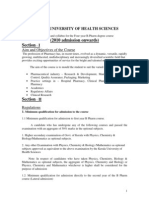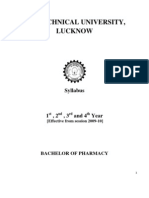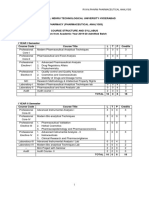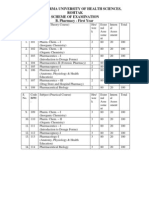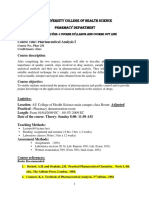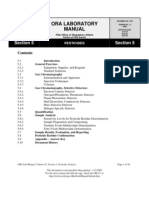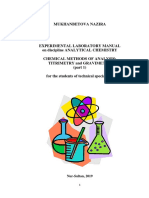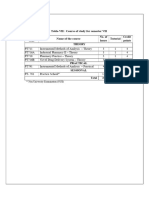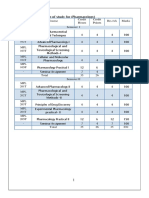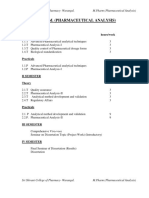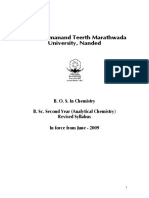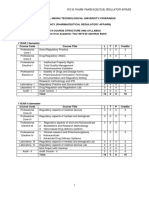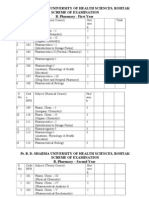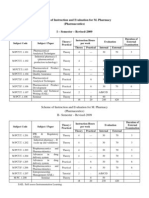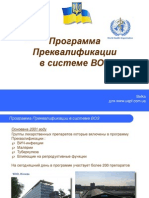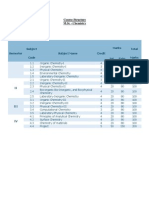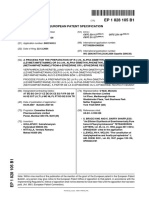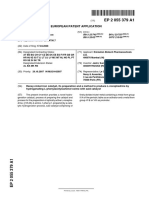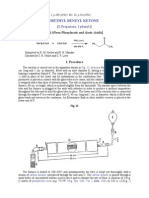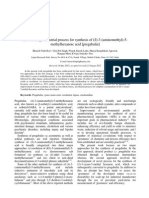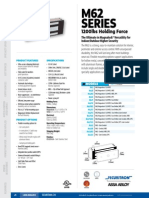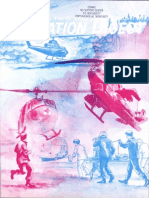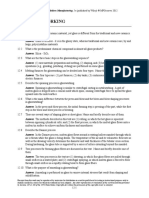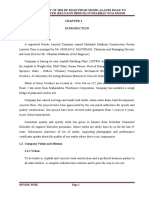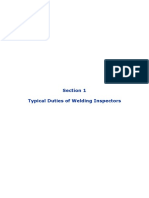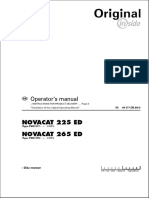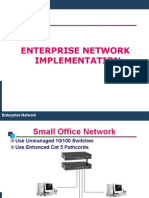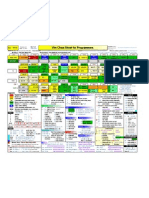B.Pharm. Syllabus
B.Pharm. Syllabus
Uploaded by
sunil_vaman_joshiCopyright:
Available Formats
B.Pharm. Syllabus
B.Pharm. Syllabus
Uploaded by
sunil_vaman_joshiOriginal Description:
Copyright
Available Formats
Share this document
Did you find this document useful?
Is this content inappropriate?
Copyright:
Available Formats
B.Pharm. Syllabus
B.Pharm. Syllabus
Uploaded by
sunil_vaman_joshiCopyright:
Available Formats
Punjab Technical University, Jalandhar B.
Pharmacy Scheme of Syllabi (1st and 2nd Semester ) 1st Semester Course No Subject L T P Examination Hours Maximum Marks for Theory Ext . Int. 80 80 40 80 80 20 20 10 20 20 Maximum Marks for Practical Ext Int. 80 40 80 80 20 10 20 20
Theory PHM 1.1.1 PHM1.1.2(M) PHM1.1.2 (B) PHM 1.1.3 PHM 1.1.4 Pharmaceutical Analysis-I Remedial Mathematics Remedial Biology Pharmacognosy-I Pharmaceutical Chemistry-I (Inorganic Pharmaceutical Chemistry) Computer Science and Applications 3 3 3 3 3 4 4 4 4 3 3 3 3 3
Practical 3 3 3 3
PHM 1.1.5 2nd Semester Course No
80
20
80
20
Subject
Examination Hours
Theory
PHM 1.2.1 PHM 1.2.2 PHM 1.2.3
PHM 1.2.4
PHM 1.2.5
Pharmaceutics-I (Physical Pharmacy) Advanced Maths Pharmaceutical Chemistry-II (Physical Chemistry) Pharmaceutical Chemistry-III (Organic Chemistry-I) Anatomy Physiology & Health Education (APHE)-I
3 4 3
4 4
3 3 3
Practical (To be conducted in 2 Batches 3 Hours for each Batch) 3 3
Maximum Marks for Theory Ext Int.
Maximum Marks for Practical Ext. Int.
80 80 80
20 20 20
80 80
20 20
80
20
80
20
80
20
80
20
* **
There will be minimum one sessional Examination in each theory subject. Internal Assessment of PRACTICAL will be based on day to day Attendance, Viva, Laboratory record etc.
Punjab Technical University, Jalandhar B. Pharmacy Scheme of Syllabi (3rd and 4th Semester ) 3rd Semester Course No Subject L T P Examination Hours Maximum Marks for Theory Ext Int. Maximum Marks for Practical Ext. Int.
Theory
PHM 2.3.1
PHM 2.3.2
PHM 2.3.3 PHM 2.3.4 PHM 2.3.5 4th Semester Course No
Pharmaceutics-II (Unit operations-I including Engg. Drawing) Pharmaceutical Chemistry (Organic Chemistry-II) Pharmacognosy-II Pharmaceutical Analysis-II APHE-II
Practical (To be conducted in 2 Batches 3 Hours for each Batch) 3
80
20
80
20
80
20
80
20
3 3 3
4 4 4
3 3 3
3 3 3
80 80 80
20 20 20
80 80 80
20 20 20
Subject
Examination Hours
Theory
PHM 2.4.1 PHM 2.4.2 PHM 2.4.3 PHM 2.4.4 PHM 2.4.5
Pharmaceutics-III (Unit Operations-II) Pharmaceutical Microbiology Pharmacognosy-III Pathophysiology of Common Diseases. Pharmaceutics-IV (Dispensing & Community Pharmacy)
3 3 3 4 3
4 4 4 4
3 3 3 3 3
Practical (To be conducted in 2 Batches 3 Hours for each Batch) 3 3 3 3
Maximum Marks for Theory Ext. Int.
Maximum Marks for Practical Ext. Int.
80 80 80 80 80
20 20 20 20 20
80 80 80 80
20 20 20 20
* **
There will be minimum one sessional Examination in each theory subject. Internal Assessment of PRACTICAL will be based on day to day Attendance, Viva, Laboratory record etc.
Punjab Technical University, Jalandhar B. Pharmacy Scheme of Syllabi (5th and 6th Semester) 5th Semester Course No Subject L T P Examination Hours Maximum Marks for Theory Ext. Int. Maximum Marks for Practical Ext. Int.
Theory
PHM 3.5.1
PHM 3.5.2
PHM 3.5.3 PHM 3.5.4 PHM 3.5.5
Pharmaceutical Chemistry-V (Biochemistry) Pharmaceutics-V (Pharmaceutical Technology-I) Pharmacology-I Pharmacognosy-IV Pharmaceutics-VI
Practical (To be conducted in 2 Batches 3 Hours for each Batch) 3
80
20
80
20
80
20
80
20
3 3 3
4 4 4
3 3 3
3 3 3
80 80 80
20 20 20
80 80 80
20 20 20
6th Semester Course No Subject L T P Examination Hours Maximum Marks for Theory Ext. Int. Maximum Marks for Practical Ext. Int.
Theory
PHM 3.6.1
PHM 3.6.2 PHM 3.6.3
PHM 3.6.4 PHM 3.6.5
Pharmaceutical Chemistry-VI (Medicinal ChemistryI) Pharmaceutical Jurisprudence & Ethics. Pharmaceutics-VII ( Biopharmaceutics & Pharmacokinetics) Pharmacology-II Pharmacognosy-V Chemistry of Natural Products).
Practical (To be conducted in 2 Batches 3 Hours for each Batch) 3
80
20
80
20
4 3
3 3
80 80
20 20
80
20
4 3
6 4
3 3
3 3
80 80
20 20
80 80
20 20
* There will be minimum one sessional Examination in each theory subject. ** Internal Assessment of PRACTICAL will be based on day to day Attendance, Viva, Laboratory record etc. There should be an industrial training of four weeks after the completion of 6th semester.
Punjab Technical University, Jalandhar B. Pharmacy Scheme of Syllabi (7th and 8th Semester) 7th Semester Course No Subject L T P Examination Hours Maximum Marks for Theory Ext. Int. Maximum Marks for Practical Ext Int.
Theory
PHM 4.7.1 PHM 4.7.2
PHM 4.7.3 PHM 4.7.4 PHM 4.7.5
PHM 4.7.6 8th Semester Course No
Pharmaceutical Biotechnology Pharmaceutics-VIII (Pharmaceutical Technology-II) Pharmaceutical Industrial Management Pharmacology-III Pharmaceutical Chemistry-VII ( Medicinal ChemistryII) Elective (Dissertation, Theory)
4 4
3 3
Practical (To be conducted in 2 Batches 3 Hours for each Batch) 3
80 80
20 20
80
20
4 3 3
4 4
3 3 3
3 3
80 80 80
20 20 20
80 80
20 20
100
Subject
Examination Hours
Theory
PHM 4.8.1 PHM 4.8.2 PHM 4.8.3
PHM 4.8.4 PHM 4.8.5
PHM 4.8.6
Pharmaceutics-IX (Dosage form design) Pharmaceutical Analysis-III Pharmaceutical Chemistry-VIII (Medicinal ChemistryVIII) Pharmacognosy-VI Pharmacology-IV (Clinical Pharmacy & Drug interactions) Project related to elective, Dissertation on Practical work)
3 3 3
3 6 3
3 3 3
Practical (To be conducted in 2 Batches 3 Hours for each Batch) 3 3 3
Maximum Marks for Theory Ext. Int.
Maximum Marks for Practical Ext. . Int.
80 80 80
20 20 20
80 80 80
20 20 20
3 4
3 -
3 3
3 -
80 80
20 20
80 -
20 -
100
* **
There will be minimum one sessional Examination in each theory subject. Internal Assessment of PRACTICAL will be based on day to day Attendance, Viva, Laboratory record etc.
SYLLABUS FOR B.PHARMACY SEMESTER-I Pharmaceutical Analysis-I PHM 1.1.1 Theory 3 hrs/ week
Significance of quantitative analysis in quality control, Different techniques of analysis, Preliminaries and definitions, Significant figures, Rules for retaining significant digits, types of errors, Mean, Standard deviation, Statistical Treatment of small data sets, Selection of sample, Precision and accuracy. Fundamentals of volumetric analysis, methods of expressing concentration, primary and secondary standards. 2. Acid Base Tirations: Acid base concepts, Role of solvent, Relative strengths of acids and bases, Ionization, Law of mass action, Common-ion effect, Ionic product of water, pH, Hydrolysis of salts, Henderson-Hesselbach equation, Buffer solutions, Neutralization curves, Acid-base indicators, Theory of indicators, Choice of indicators, Mixed indicators, Polyprotic system, Polyamine and amino acid systems, Amino acid titration, applications in assay of H3PO4, NaOH, CaCO3 etc. 3. Oxidation Reduction Titrations: Concepts of Oxidation and reduction, Redox reactions, Strengths and equivalent weights of oxidizing and reducing agents, Theory of Rredox titrations, Redox indicators, Cell representations, Measurement of electrode potential, Oxidation-reduction curves, Iodimetry and Iodometry, Titrations involving ceric sulphate, potassium iodate, potassium bromate, potassium permanganate; titanous chloride and Sodium 2, 6-dichlorophenol indophenol. 4. Precipitation Titrations: Precipitation reactions, Solubility products, Effects of acids, temperature and solvent upon the solubility of a precipitate. Argentometric titrations and titrations involving ammonium or potassium thiocyanate,mercuric nitrate, and barium sulphate, Indicators, Gay-Lussac method; Mohr's method, Volhard's method and Fajan's method. 5. Gravimetric Analysis: Precipitation techniques, Solubility products; the colloidal state, Supersaturation coprecipitation, Post-precipitation, Digestional washing of the precipitate, Filtration, Filter papers and crucibles, Ignition, Thermogravimetric curves, Specific examples like barium sulphate, aluminium as aluminium oxide, calcium as calcium oxalate and magnesium as magnesium pyrophosphate, Organic precipitants. PHM 1.1.1 Practicals 4 hrs/ week The students should be introduced to the main analytical tools through demonstrations. They should have a clear understanding of a typical analytical balance, the requirements of a good balance, weights, care and use of balance, methods of weighing and errors in weighing. The students should also be acquainted with the general apparatus required in various analytical procedures. 1. Standardization of analytical weights and calibration of volumetric apparatus. 2. Acid base Titrations : Preparation and standardization of acids and bases; some exercises related with determination of acids and bases separately or in mixture form, some official assay procedures e.g. boric acid should also be covered. 3. Oxidation Reduction Titrations : Preparation and standardization of some redox titrants e.g. potassium permanganate, potassium dichromate, iodine, sodium thiosulphate, etc. Some exercises related to determination of oxidizing and reducing agents in the sample shall be covered. Exercises involving potassium iodate, potassium bromate, iodine solution, titanous chloride, sodium 2, 6- dichlorophenol indophenol, and ceric ammonium sulphate. 4. Precipitation Titrations : Preparation and standardization of titrants like silver nitrate and, ammonium thiocyanate, Titrations according to Mohr's, Volhard's and Fajan's methods. 5. Gravimetric Analysis : Preparation of gooch crucible for filtration and use of sintered glass crucible, Determination of water of hydration, Some exercises related to gravimetric analysis should be covered. BOOKS RECOMMENDED 1. Beckett, A.H., and Stanlake, J.B. Practical Pharmaceutical Chemistry, Athilone Press, London. 2. Jeffery, G.H., Bessett, J., Mendham J. and Denney, R.C., Vogel's Textbook of Quantitative Inorganic Analysis including Elementary Instrumental Analysis 4th ed. the ELBS and Longman London, 1978. 3. Atherden, L.M. Bentley and Driver's Textbook of Pharmaceutical Chemistry. 8th ed. Oxford University Press, Delhi. 1969 4. Gary, D.C.Analytical Chemistry 4th ed. John Wiley and Sons, New York, 1986.
1.
Suggested Readings
1. 2. 3. 4.
Connors, K.A. Textbook of Pharmaceutical Analysis.3rd Edition. John Wiley & Sons, New York. Kalthoff, I.M. and Stenger, V.A. Volumetric Analysis Vol.II Titration Methods. Interscience Publishers Inc., New York. Varma, R.M. Analytical Chemistry, Theory & Practice. 3rd edition CBS Publishers & Distributors, New Delhi. I.P. 1996
SEMESTER-I Remedial Mathematics PHM 1.1.2(M) Theory 1. 4 hrs/weeks
Algebra: Equations reducible to quadratics, simultaneous equations (linear and quadratic), Determinants, properties of solution of simultaneous equations by Cramer's rule, matrices, definition of special kinds of matrices, arithmetic operations on matrices, inverse of a matrix, solution of simultaneous equations by matrices, pharmaceutical applications of determinants and matrices. Mensuration and its pharmaceutical applications. Measures of Central Value: Objectives and pre -requisites of an ideal, measure, mean, mode and median.
2.
3. Trignometry: Measurement of angle, T-ratios, addition, subtraction and transformation formulae, T-ratios of multiple, submultiple, allied and certain angles .. Application of logarithms in pharmaceutical computations. 4. Analytical Plane Geometry: Certain co-ordinates, distance between two points, area of triangle, a locus of point, straight line; slope and intercept from, double-intercept form, slope-point and two point form, general equation of first degree. 5. Calculus: Differential: Limits and functions, definition of differential coefficient, differentiation of standard functions, including function of a function (Chain rule). Differentiation of implicit functions, logarithmic differentiation, parametric differentiation, successive differentiation. Integral: Integration as inverse of differentiation, indefinite integrals of standard forms, integration by parts, substitution and partial fractions, formal evaluation of definite integrals. BOOKS RECOMMENDED
1. 2.
A Textbook of Mathematics for XI-XII Students. NCERT Publications. Vol I-IV 1991 Grewal, B.S.Higher Engineering Mathematics. Khanna Publishers, New Delhi,1990
Suggested Reading 1. Schaum's Differential Equations. Mc Graw Hill,Singapore
SEMESTER-I
Remedial Biology PHM 1.1.2 (B)Theory 1. 2. Methods of classification of plants. Plant Cell: Its structure and non-living inclusions; mitosis and meiosis; different types of plant tissues and their functions. 3 hrs/ weeks
3. Morphology and histology of root, stem, bark, wood, leaf, flower, fruit and seed. Modification of root and stem. 4. General Survey of Animal Kingdom; Structure and life history of parasites as illustrated by amoeba, entamoeba, trypanosoma, plasmodium, taenia, ascaris, schistosoma, oxyuris, and ancylostoma. 5. General Structure and life history of insects like mosquito, housefly, mites and silkworm. PHM 1.1.2 (B) Practical (Remedial Biology) 3 hrs/week
1. Morphology of plant parts indicated in Theory. 2. Care, use and type of microscopes. 3. Gross identification of slides of structure and life cycle of lower plants/ animals mentioned in Theory. 4. Morphology of plant parts indicated in Theory. 5. Preparation, microscopic examination of stem, root and leaf of monocot and dicot plants. 6. Structure of human parasites and insects mentioned in Theory with the help of specimens. BOOKS RECOMMENDED
1. Fahn, A.Plant Anatomy 3rd ed. Pergamon Press, Oxford. 2. Reinest, J and Bajaj, Y.P.S. Applied and Fundamental aspects of Plant Cell, Organ Culture, Berlin. 3. Swain, T.Chemical Plant Taxonomy, Academic Press, London.
Tissue and
SEMESTER-I Pharmacognosy -I PHM 1.1.3 Theory 3 hrs/ week
1. Definition, history, scope and development of Pharmacognosy. 2. Sources of drugs: Biological, marine, mineral and plant tissue cultures as sources of drugs. 3. Classification of drugs: e.g. Alphabetical, morphological, taxonomical, chemical and pharmacological.
4. Plant taxonomy: Study of the following families with special reference to medicinally important plantsApocynacae, Solanaceae, Rutaceae, Umbelliferae, Leguminosae, Rubiaceae,Liliaceae, Graminae, Libiatae, Cruciferae, Papaveraceae. 5. Cultivation, collection, processing and storage of crude drugs: Factors influencing cultivation of medicinal plants. Types of soils and fertilizers of common use. Pest management and natural pest control agents. Plant hormones and their applications. Polyploidy, mutation and hybridization with reference to medicinal plants.
6. Quality control of crude drugs: Adulteration of crude drugs and their detection by organoleptic, microscopic, physical, chemical and biological methods of evaluation. 7. An introduction to active constituents of drugs: Their isolation, classification and properties.
8. Systematic pharmacognostic study of following: a) Carbohydrates and derived products: Agar, Guar gum, Acacia, Honey, Isabgol, Pectin, Starch, Sterculia and Tragacanth. b) Lipids: Bees wax, Castor oil, Cocoa butter, Cod-liver oil, Hydnocarpus oil, Kokum butter, Lard, Linseed oil, Rice-bran oil, shark liver oil and wool fat. PHM 1.1.3 Practical 4 hours/week
1. Morphological characteristics of plant families mentioned in Theory. 2. Microscopic measurements of cells and cell contents: Starch grains, calcium oxalate crystals and phloem fibres. 3. Determination of leaf constants such as stomatal index, stomatal number, veinislet number, vein-termination number and palisade ratio. 4. Identification of crude drugs belonging to carbohydrates and lipids. 5. Preparation of herbarium sheets.
BOOKS RECOMMENDED 1 Kokate, C.K. Practical Pharmacognosy. Vallabh Prakashan, Delhi. Kokate, C.K., Purohit, A.P. and Gokhale, S. B. Pharmacognosy (Degree). Nirali Prakashan, Pune. Trease, G.E. and Evans W.C.Pharmacognosy. Baillier , Tindall, Eastbourne, U.K.
2. 3.
4 . Wallis, T.E. Textbook of Pharmacognosy. J and AChurchill Ltd., London. Suggested Books 1. Atal, C.K. and Kapur, B.M. Cultivation and Utilization of Medicinal Plants. R. R. L , Jammu.
2. Gibbs, R.D. Chemotaxonomy of Flowering Plants. 4 Volumes McGill University Press. 3. Schallard, E.J. Practical Plant Chemistry for Pharmacy , Students. Pitman Medical, London. 4. Shah, C.S. and Quadry, J.S. Textbook of Pharmacognosy, B.S.Shah Publishers, Ahmedabad 5. Tyler, V.C.Brady, L.R. and Robers, J.E.Pharmacognosy. Lea and Febiger, Philadelphia. 6. Tyler, V..E.Jr. and Schwarting A.E.Experimental Pharmacognosy. Burgers Pub. Co., Minnesota. 7. Wallis, T.E. Analytical Microscopy . J and A Churchill Ltd., London Minneapolis,
SEMESTER-I
Pharmaceutical Chemistry-I (Inorganic Pharmaceutical Chemistry) P.H.M 1.1.4 Theory 3 hrs/week
An outline of methods of preparation, uses, sources of impurities, tests for purity and identity,including limit tests for iron, arsenic, lead, heavy metals chloride, sulphate and special test if any, of the following classes of inorganic pharmaceuticals included in Indian Pharmacopoeia. 1. Acids and Bases : Buffers, Water.
2. Gastrointestinal Agents: Acidifying agents, Antacids, Protectives and Adsorbents, Cathartics. 3. Major Intra- and Extra-cellular Electrolytes : Physiological ions. Electrolytes used for replacement therapy, 4. Essential and Trace Elements: Transition elements and their compounds of pharmaceutical importance: Iron and haematinics, mineral supplements. 5. Cationic and anionic components of inorganic drugs useful for systemic effects. 6. Topical Agents: Protectives, Astringents and Anti- infectives. 7. Gases and Vapours: Oxygen, Anesthetics and Respiratory stimulants. 8. Dental Products: Dentifrices, Anti-caries agents.
9. Complexing and chelating agents used in therapy. 10. Miscellaneous Agents: Sclerosing agents, expectorants, emetics, Pharmaceutical Aids Used in Pharmaceutical Industry. Anti- oxidants, excipients, suspending agents, colorants etc. 11. Inorganic Radio pharmaceuticals: Nuclear radio-pharmaceuticals, obtaining their standards and units of activity,measurement of activity, precautions. P.H.M 1.1.4 Practicals 4 hrs/week poisons and antidotes, sedatives etc. preservatives, filter aids, adsorbents, diluents, Reactions, Nomenclature, Methods of clinical applications and dosage, hazards and
The background and systematic qualitative analysis of inorganic mixtures of up to four radicals. Six Mixtures to be analyzed, preferably by semi-micro methods. All indentification tests for pharmacopoeal inorganic pharmaceuticals and qualitative tests for cations & anion should be covered . BOOKS RECOMMENDED 1. Block, J.H., Roche, E, Soine, T.O. and Wilson, C.O. Inorganic Medicinal and Pharmaceutical Chemistry Lea and Febiger, Philadelphia, PA. 2. Discher, L.A. Modern Inorganic Pharmaceutical Chemistry. 3. Suchla, G.Vogel's Textbook of Micro and Semmicro Qualitative Inorganic Analysis. Orient Longman, Hyderabad . SUGGESTED READING 1. Qadry, J.S. and Qadry, S.Z. Textbook of Inorganic Pharmaceutical and Medicinal Chemistry. B.S. Shah Prakashan, Ahmedabad.
Semester-I Computer Science and Applications PHM 1.1.5 Theory Aim : 4Hrs/Week
1. 1.1
1.2 1.3 2
3.
4.
6. 6.1 6.2 6.3 6.4 6.5
The objective of this paper is to acquaint the pharmacy students of Semester I with the fundamental principles of computers, their applications and basic elements of programming only. The paper-setter should set the question papers and examiners should evaluate the answers accordingly. Computer Fundamentals : Introduction to computers : Characteristics of computers, Historical perspectives of computers, computer generations, types of computers and uses, Software, Hardware, Basic architecture and functions of CPU and its parts, Important I/O devices like Keyboard, Mouse, Printers, Video Monitors. Number System : Decimal, Binary, Basic Binary arithmetic (Conversion to and from decimal numbers, Binary addition and subtraction ). Memory Storage : Memory Cells, Semiconductor and Magnetic core memory, ROM ( its types), RAM, Cache and Virtual memory, Secondary storage devices and their organization (Hard disk, Floppy disk, CD, DVD). Operating Systems : Definitions, Need, Organization, Functions, Types of Operating Systems, DOS, Windows, Handling Drives, Directories and files, Commands (Internal & External), Icons, Clipboard, Folders, Major differences between DOS & Windows,. Communication Networks : Hardware and software components, Seven layers of OSI architecture, Network Topologies (Ring, Star, Fully Connected and Bus), LAN and WAN, Bounded and unbounded communication media, Internet, World Wide Web and I.T., Browsers, Important terminology regarding Internet applications, Electronic Mail, Potential uses and abuses of Internet. Computer Programming: Programming languages, Classifications, Low level and high level languages, merits and pitfalls of languages, object oriented languages, Syntax and semantics, Basic steps involved in software development, Flow charts, Compilers and Interpreters. Simple programming using C Data types, Constants, Variables, Arithmetic and relational expressions, Symbolic constants, Input and output assignment statements, If-else, Switch statements, Loops ( While, do-while and for), Transfer statements, Arrays, Problem solving using C taking simple algorithms. Computer Applications : Word processing : Techniques, File manipulation, Formatting, Printing setups Table handling, Mail merge, etc. using MSWord. Spreadsheet package : Worksheets, Formatting sheets, Calculations and graphing using formulae and functions, Import and export of data using MS-Excel. Graphics : Objectives and types of graphics , Presentation packages, Slides designing, Diagrams and graphs, Import and Export data using MS-Power Point. Data security against viruses : Definition of computer viruses, Detection, prevention and cure against viruses using antivirus software packages. Pharmaceutical applications : Basics of computer use in various pharmaceutical and clinical applications like drug information services, hospital and community pharmacy, drug design, pharmacokinetics and data analysis. 4 Hrs/Week
Practicals : Simple exercises based upon the following need to be dealt : 1. Computer operating systems like MS-DOS, MS-Windows. 2. Word-processing like MS-Word. 3. Spreadsheet calculations using MS- Excel. 4. Graphic applications using MS-Power Point, MS-Excel. 5. Programming using C. Book references (for Theory and Practicals): 1. Fundamentals of Computers by Rajaraman, Prentice Hall of India 2. Let us C by Kanetkar, BPB Publications. 3. Learn MS-Office 2000 by Stultz, BPB Publications. 4. Using Microsoft Windows 1998 by Ivens, Prentice Hall of India. 5. Learn DOS in a day by Stultz, BPB Publications.
10
SEMESER-II Pharmaceutics-I (Physical Pharmacy) PHM 1.2.1 Theory 1. 3 hrs/week
2.
3.
4.
5.
6. 7. 8.
Matter and Properties of Matter :State of matter, change in the state of matter, latent heats and vapor pressure, sublimation-critical point, Eutectic mixtures, gases, aerosols -inhalers, relative humidity, liquid complexes, liquid crystals, glassy state, solids-crystalline, amorphous and polymorphism. Micromeretics and Powder Rheology: Particle size and distribution, average particle size, number and weight distribution, particle number, methods for determining particle volume, optical microscopy, sieving, sedimentation, measurement, particle shape, specific surface, methods of determining surface area, permeability, adsorption, derived properties of powders, porosity, packing arrangement, densities, bulkiness & flow propeties. Surface and Interfacial Phenomena: Liquid interface, surface and interfacial tensions, surface free energy, measurement of surface and interfacial tensions, spreading coefficient, adsorption at liquid interfaces, surface active agents, HLB classification, solubilization, detergency, adsorption at solid interfaces, solid- gas and solid-liquid interfaces, complex films, electrical properties of interface. Viscosity and Rheology: Newtonian systems, Law of flow, kinematic viscosity, effect of temperature, non-Newtonian systems, pseudoplastic, dilatant, plastic, thixotropy, thixotropy in formulation, determination of viscosity, capillary, falling ball, rotational viscometers. Dispersion Systems: Colloidal Dispersions: Definition, types, properties of colloids, protective colloids, applications of colloids in pharmacy; Suspensions and Emulsions: Interfacial properties of suspended particles, settling in suspensions, theory of sedimentation, effect of Brownian movement, sedimentation of flocculated particles, sedimentation parameters, wetting of particles, controlled flocculation, flocculation in structured vehicles, rheological considerations; Emulsions-types, theories, physical stability. Complexation: Classification of complexes, methods of preparation and anlaysis, applications. Kinetics and Drug Stability: General considerations & concepts,half-life determination, Influence of temperature, light, solvent, catalytic species and other factors, Accelerated stability study, expiration dating. Buffers: Buffer equations and buffer capacity in general, buffers in pharmaceutical systems, preparation, stability, buffered isotonic solutions, measurements of tonicity, calculations and methods of adjusting isotonicity. PHM 1.2.1 Practicals 4 hrs/week
I. Determination of particle size, particle size distribution and surface area using various methods of Particle size analysis. II. Determination of derived properties of powders like densities, porosities, compressibility, angle of repose etc. III. Determination of surface/interfacial tension, spreading coefficient HLB value, and critical micellar concentration of surfactants. IV. Study of rheological properties of various types of systems using different Viscometers. V. Preparation of various types of suspensions and determination of their sedimentation parameters. VI. Preparation and stability studies of emulsions. VII. Studies on different types of complexes and determination of their stability constants. VIII. Accelerated stability testing, shelf-life determination and expiration dating of pharmaceuticals IX. Preparation of pharmaceutical buffers and determination of buffer capacity. X Experiments involving tonicity adjustments. BOOKS RECOMMENDED
1. 2. 3.
Martin, A., Cammarata, A., and Swarbrick, J.Physical Pharmacy. K.M.Varghese & Co., Mumbai. Shotton, E. and Ridgaway, K.Physical Pharmaceutics. Oxford University Press, London. Subhramanyam. C.V.S. Textbook of Physical Pharmaceutics. Vallabh Prakashan, New Delhi. SUGGESTED READINGS
1. 2. 3.
Connores, K.A., Amiden, G.L. and Stella, V.J. Chemical Stability of Pharmaceuticals. John Wiley and Sons, New York. Gennaro, A.R. Ed. Remington's Pharmaceutical Sciences. 19th ed. Mack Publishing Co., Eastern Pennsylvania, 2000
Martin, A., Bustamante, P., Chun, A.H.C. Physical Pharmacy. 4th Edition. B.I. Waverley (P) Ltd., New Delhi.
11
SEMESTER-II
Advanced Mathematics PHM 1.2.2 Theory 4 hrs/week
1. Differential equations: Revision of integral calculus, definition and formation of differential equations, equations of first order and first degree, variable separable, homogeneous and linear differential equations and equations reducible to such types, pharmaceutical applications. 2. Laplace Transforms: Definition, transforms of elementary functions, properties of linearity and shifting, inverse laplace transforms, transforms of derivatives, solution of ordinary and simultaneous differential equations. 3. Biometrics: Significant digits and rounding of numbers, data collection, random and non-random sampling methods, sample size, data organization, diagrammatic representation of data, bar, pie, 2-D and 3-D diagrams, measures of central tendency, measures of dispersion, Standard deviation and standard error of means, coefficient of variation, confidence (fiducial) limits, probability and events, Bayes' theorem, probability theorems, probability distributions, elements of binomial and Poisson distributions, normal distribution curve & properties, kurtosis and skewness, correlation and regression analysis, method of least squares, statistical inference, Student's and paired ttest, F-test and elements of ANOVA, applications of statistical concepts in Pharmaceutical Sciences. BOOKS RECOMMENDED 1. 2. 3. 4. Bolton's Pharmaceutical Statistics. Practical and Clinical Applications. Marcel Dekker, New York, 1990 Daniel, W.W.Biostatistics. A Foundation for Analysis in Health Sciences. John Wiley, New York 1983 Grewal, B.S.Higher Engineering Mathematics. Khanna Publishers, New Delhi, 1990. Gupta, S.P. Statistical Methods. Sultan Chand & Co., New Delhi, 1990. SUGGESTED READINGS 1. Schaum's Differential Equations. McGraw-Hill, Singapore, 1982.
SEMESTER-II Pharmaceutical Chemistry-II (Physical Chemistry) PHM 1.2.3Theory 1. Behaviour of Gases: 3 hrs/week Kinetic theory of gases, deviation from ideal behaviours and explanation.
2. The Liquid State: Physical properties (surface tension, parachor, viscosity, refractive index, optical rotation, dipole moments and chemical constituents). 3. Solutions: Ideal and real solutions, solutions of gases in liquids, colligative properties, partition coefficient, conductance and its measurement, Debye Huckel theory. 4. Thermodynamics: First, second and third laws, Zeroth law, absolute temperature scale, thermochemical equations, phase equilibria and phase rule. 5. Adsorption: Freudlich and Gibbs adsorption, isotherms, Langmuir theory of adsorption. 6. Photochemistry: Consequences of light absorption, Jablenski diagram, Lambert-Beer Law, Quantum efficiency. 7. Chemical Kinetics: Zero, first and second order reactions, complex reactions, theories of reaction kinetics, characteristics of homogeneous and heterogeneous catalysis, acid base and enzyme catalysis. 8. Quantum Mechanics: Postulates of quantum mechanics, operators in quantum mechanics, the Schrodinger wave equation. PHM 1.2.3 Practicals 4 hrs/week 1. To determine molar mass by Rast method and cryoscopic method. 2. To determine refractive index of given liquids and find out the contribution of carbon, hydrogen and oxygen in molar refraction of a compound. 3. To determine molar mass of volatile liquids by Victor-Meyer method.
12
4.
To determine the specific rotation of sucrose at various concentrations and determine the intrinsic rotation.
5. To determine the heat of solution, heat of hydration and heat of neutralization. 6. To determine the cell constant, verify Ostwald dilution law and perform conductometric titration.
7. To determine rate constant of simple reaction.
BOOKS RECOMMENDED 1. Laidler, K.J.Physical Chemistry with Biological Applications. Benjamin. 1980 2. Shoemaker, D.P. and Garland, C.W. Experiments in Physical Chemistry. McGraw Hill Book Co. New York. 3. Puri, B.R., Sharma, L.R. and Pathania, M.S. Principles of Physical Chemistry. Shoban Lal Nagin Chand & Co. 1993
SUGGESTED READINGS 1. 2. 3. 4. 5. 6. Brey, W.S. Physical Chemistry and Biological Applications. Academic Press, 1978. Kitckner, J.A.Ed. Findley's Physical Chemistry. Green & Co., London Wallwork, S.C. Physical Chemistry for Students of Pharmacy and Biology. Longman Pali, S.R. and Prabartak, S.K.D.E. Practical Physical Chemistry. Haltone Ltd., Calcutta Williams, V.R. and Williams, H.S.Basic Physical Chemistry for the Life Sciences. W.H. Freeman
Barrante, J.R.Physical Chemistry of the Life Sciences. Printell
13
SEMESTER-II Pharmaceutical Chemistry-III (Organic Chemistry-1) PHM 1.2.4 Theory 4 hrs/week
The subject of organic chemistry will be treated in its modern perspective keeping for the sake of convenience, the usual classification of organic compounds. 1. Structure and Properties: Atomic structure, Atomic orbitals, Molecular orbital theory, wave equation, Molecular orbitals, Bonding and Antibonding orbitals, Covalent bond, Hybrid orbitals, Intramolecular forces, Bond dissociation energy, Polarity of bonds, Polarity of molecules, structure and physical properties, Intermolecular forces , Acids and bases. Stereochemistry: Isomerism & nomenclature and associated physicochemical properties, optical activity, stereoisomerisms, specification of configurtion, reactions involving stereoisomerisms, chirality, chiral reagent, conformations.
2.
2. Structure, Nomenclature and Properties with special Emphasis on reaction Mechanism :Alkanes, Alkenes, Alkynes; Cycloalkanes , Dienes, Benzene,Polynuclear aromatic compounds, Arenes, Alkyl halides, Alcohols, Ethers, Epoxides, Amines, Phenols, Aldehydes and ketones, Carboxylic acids, Functional derivatives of carboxylic acids, Reactive intermediates- carbocations, carbanions, carbenes, nitrene and nitrenium ions. PHM 1.2.4 Practical 6 hrs/week
1. The student should be introduced to the various laboratory techniques through demonstrations involving synthesis of selected organic compounds (e.g. aspirin, p-bromoacetanilide, anthraquinone from anthracine, reduction of nitrobenzene, etc.) 2. Identification of organic compounds and their derivatisation. 3. Introduction to the use of stereo models. BOOKS RECOMMENDED
1. Mann, F.C. and Saunderes, B.C. Practical Organic Chemistry. ELBS/ Longman. London 2. Morrison, T.R. and Boyd, R.N. Organic Chemistry. Prentice Hall of India, New Delhi 3. Roberts, J.D. and Caserio, M.C. Basic Principles of Orgenic Chemistry. W.A. Benjamin, Inc., New York.
8. Vogel, A.I. A Textbook of Practical Organic Chemistry. ELBS/ Longman, London
SUGGESTED READINGS 1. Eliel, E.L.Stereochemistry of Organic Compounds McGraw Hill Book Co., Inc., New York. 2. Finar, I.L. Organic Chemistry Vols. I & II ELBS/Longman, London 3. Furniss, N.S., Hannaford, A.J., Smith, P.W.G. and Tatehell, A.R. Vogel's Textbook of Practical Organic Chemistry. ELBS/Longman, London
4. Sykes, P.A. A Guidebook to Mechanism in Organic Chemistry. Orient Longman, New Delhi.
14
SEMESTER-II Anatomy, Physiology & Health Education(APHE)-I
PHM 1.2.5 Theory 1)
3 hrs/week
Scope of anatomy and physiology and basic medical terminology used in these subjects. Structure of cell, its components and their functions. Elementary Tissues of the Human Body: Epithelial, connective, muscular and nervous tissues, their sub-types and their characteristics. 2) Anatomy and Physiology with emphasis to various system . 2.1 Osseous System: Structure, composition and functions of skeleton, Classification of joints, types of movements of joints, Disorders of joints. 2.2 Skeletal Muscles: Gross anatomy; physiology of muscle contraction, physiological properties of skeletal muscles and their disorders. 2.3 Haemopoietic System: Composition and functions of blood and its elements, their disorders, blood groups and their significance, mechanism of coagulation, disorders of platelets and coagulation. 2.4 Lymph and Lymphatic System: Composition, formulation and circulation of lymph; disorders of lymph and lymphatic system. Basic physiology and functions of spleen. 2.5 Cardiovascular System: Basic anatomy of the heart, Physiology of heart, blood vessels and circulation. Basic understanding of Cardiac cycle, heart sounds and understanding of Cardiac cycle, heart sounds and electrocardiogram. Blood pressure and its regulation. Brief outline of cardiovascular disorder like hypertension, hypotension, arteriosclerosis, angina, myocardial infarction, congestive heart failure and cardiac arrhythmias. PHM 1.2.5 Practicals 4 hrs/week 1. 2. 3. 4. Study of human skeleton. Study of different systems with the help of charts and models. Microscopic study of different tissues. Estimation of hemoglobin in blood. Determination of bleeding time, clotting time, R.B.C.Count, Total leucocyte count, D.L.C. and E.S.R. 5. Recording of body temperature, pulse rate and blood pressure, basic understanding of Electrocardiogram-PQRST waves and their significance. BOOKS RECOMMENDED Tortora, G.J. and Grabowski, S.R. Principles of Anatomy and Physiology. Collins College Publishers, Luciano, New York. 1. Eroschenko, V.P. Difores Atlas of Histology with functional correlations. Lippincott Williams & Williams. 2. Ghai, C.L. A Textbook of Practical Physiology Jay Pee Brothers, New Delhi. 3. Guyton, A.C. & Hall, J.E. Textbook of Medical Physiology. W.B. Sanders Co. SUGGESTED READING 1. Chaurasia, B.D. Human Anatomy, Regional and Parts I, II & III. CBS Publishers & Distributors, New Delhi. 2. Difore, S.H. Atlas of Normal Histology. Lea & Febiger , Philadelphia 3. Chatterjee, C.C. Human Physiology, Medical Allied Agency, Calcutta 4. Subhash, S.Human Physiology, Medical Allied Agency, Calcutta 5. Keele, C.A., Neil, E. and Joels, N.Samson Wright's Applied Physiology. Oxford University Press 6. McNaught, A.B. and Callander, R Illustrated Physiology. Churchill Livingstone. 7. Parmar, N.S. Health Educations and Community Pharmacy, CBS Publishers & Distributors, New Delhi 8. Ranade, V.G. Textbook of Practical Physiology. Pune Vidyarthi Griha Parkas Han, Pune 9. Vander, A.J., Sherman, J.H. and Lucians, D.S. Human Physiology. Tata McGraw Hill Publishing Co., New Delhi 10. Ganong, W.F. Review of Medical Physiology. Prentice. Hall Guyton, A.C., Hall, J.E. Textbook
15
SEMESTER-III Pharmaceutics-II (Unit Operations I) PHM 2.3.1 Theory 3 hrs / week
1. Unit Operations: Introduction, basic laws. 2. Fluid Flow : Types of flow, Reynolds number, Viscosity, Concept Of boundary layer, basic equations of fluid flow, valves, flow meters, manometers and measurement of flow and pressure. 3. Material Handling Systems: a. Liquid handling- Different types of pumps. b.Gas handling- various types of fans, blowers and compressors. c.Solid handling- Bins, Bunkers, Conveyers, Air transport. 4. Filtration and Centrifugation: Theory of filtration, filter aids, filter media, industrial filters including filter press, rotary filter, edge filter, etc. Factors affecting filtration, mathematical problems on filtration, optimum cleaning cycle in batch filters. Principles of centrifugation, industrial centrifugal filters, and centrifugal sedimenters. 5. Crystallization: Characteristics of crystals like-purity, size, shape,geometry, habit, forms size and factors affecting them. Solubility curves and calculation of yields. Supersaturation theory and its limitations, Nucleation mechanisms, Crystal growth. Study of various types of Crystallizers, tanks, Caking of crystals and its prevention. Numerical problems on yields. 6. Dehumidification and Humidity Control: Basic concepts and definition, wet bulb and adiabatic saturation temperatures, Psychrometric chart and measurement of humidity, application of humidity measurement in pharmacy, equipments for dehumidification operations. 7. Refrigeration and Air Conditioning : Principles and applications of refrigeration and air conditioning. 8. Material of Construction : General study of composition, corrosion, resistance, Properties and applications of the materials of construction with special reference to stainless steel and glass. Factors affecting the choice. 9. Industrial hazards and Safety Precautions: Mechanical, Chemical, Electrical, fire and dust hazards. Industrial dermatitis, Accident records etc. PHM 2.3.1 1. 2. 3. 4. 5. 6. 7. 8. Practicals 4 hrs /week Measurement of flow of fluids and their pressure, determination of Reynolds number and calculation of Frictional losses. Evaluation of filter media, determination of rate of filtration and Study of factors affecting filtration. Experiments to demonstrate applications of centrifugation. Thermometers and Psychrometric charts. Determination of humidity-use of Dry Bulb and Wet Bulb. Elementary Knowledge of Engineering Drawing-Concept of orthographic and isometric views of elevation and third angle projection. Notation and abbreviation used in Engineering drawing. Basic Engineering Drawing Practice- Bolts, nuts, rivetted fronts, screws, worm screws as per specification. Drawing of simple pharmaceutical machinery parts.
Books Recommended Pharmaceutics-II (Unit Operations-I) 1. 2. 3. 4. Badger, W.L. and Banchero, J.T. Introduction to Chemical Engineering. McGraw Hill International Book Co., London. Brown, C.G. Unit Operations (Indian Ed.) CBS Publishers & Distributors. McCabe , W.L. and Smith, J.C. and Harriolt, P.Unit Operations of Chemical Engineering.5th Edition McGraw Hill International Book Co., London. Bhatt N.D. and Panchal, V.M. Machine Drawing Charocar Publishing House, Opp. Amul Dairy, Anand , 388001 (India) . Suggested Reading 1. Perry, R.H. & Green, D.W. Chemical Engineers Handbook. McGraw Hill, International Editors Ltd. SEMESTER-III Pharmaceutical Chemistry-IV (Organic Chemistry-II) PHM 2.3.2 Theory 3 hrs/week
16
1. Nucleophillic aromatic substitutions; -unsaturated carbonyl compounds; Conservation of orbital symmetry and rules. Electrocyclic, Cycloaddition and sigmatropic reactions; Neighbouring group effects; Catalysis by transition metal complexes, Stereoselective and sterospecific reactions; New organic reagents used in drug synthesis. 2. Heterocyclic Compounds: Chemistry, preparations and properties of some important heterocyclics containing 3,4,5,6, & 7 atoms with one or two heteroatoms like O, N, S. 3. Chemistry of Lipids, Carbohydrates, Proteins and Nucleic acids. PHM 2.3.2 Practicals 4 hrs/week
At least five exercises in synthesis involving various heterocyclic ring systems. An exercise involving stereoselective synthesis of a compound. Resolution of racemic DL-alanine or any other example. Workshop on molecular modelling of primary, secondary and tertiary structures of proteins, molecular modelling on double helical structure of nucleic acid showing hydrogen bonding. Determination of physico-chemical constants for oils and fats; preparation of organic compounds. Books Recommended Pharmaceutical Chemistry-IV (Organic Chemistry) Acheson, R.N. An Introduction to the Chemistry of Heterocyclic Compounds. Interscience Publishers, N.Y. Finar, I.L. Organic Chemistry. Vol. I & II ELBS/Longman, London. Furniss, B.S., Hannaford, A.J., Smith, P.W.G. and A.R. Tatehell. Vogels Textbook of Practical Organic Chemistry. Addison Wesley Longman. Morrison, R.T. and Boyd, R.N. Organic Chemistry. Prentice Hall of India, N.Delhi. Suggested Readings Roberts, J.D. and Caserio, M.C. Basic Principals of Organic Chemistry.W.A. Benjamin, Inc., N.Y. Sykes, P. A Guide book to Mechanism in Organic Chemistry. Orient Longman, N.Delhi. Paquette, L.A. Advanced Heterocyclic Chemistry.
1. 2. 3. 4.
1. 2. 3.
17
SEMESTER-III Pharmacognosy-II PHM 2.3.3 1. Theory 3 hrs / week
Resins: Study of Drugs Containing Resin and Resin Combination like Colophony, podophyllum, jalap, cannabis, capsicum, myrrh, asafoetida, balsam of tolu, balsam of peru, benzoin, turmeric, ginger. Tannins: Study of tannins and tannin containing drugs like Gambir, black catechu, gall and myrobalan. Volatile Oils: General methods of obtaining volatile oils from plants. Study of volatile oils of Mentha, Coriander, Cinnamon, Cassia, Lemon peel, Orange peel, Lemon grass, Citronella, Caraway, Dill, Spearmint, Clove, Fennel, Nutmeg, Eucalyptus, Chenopodium, Cardamom, Valerian, Musk, Palamarosa Gaultheria, Sandal wood. Phytochemical Screening: a) Preparation of extracts. b) Screening of alkaloids, saponins, cardenolides and bufradienolides, flavonoids and leucoanthocyanidins, tannins and polyphenols, anthraquinones, cynogenetic glycosides, amino acids in plant extracts.
2. 3.
4.
5.
Fibres: Study of fibres used in pharmacy such as cotton, silk, wool, nylon, glass-wool, polyester and asbestos. Pharmaceutical aids: Study of pharmaceutical aids like talc, diatomite, kaolin, bentonite, gelatin and natural colors. PHM 2.3.3 1. 2. 3. Practicals 4 hrs /week
6.
Identification of crude drugs mentioned in theory . Study of fibres and pharmaceutical aids. Microsopic studies of seven-selected crude drugs and their powders mentioned under the category of volatile oils in theory and their chemical test. General chemical tests for alkaloids, glycosides, steroids, flavonoids and tannins.
4.
Books Recommended Pharmacognosy II 1. 2. 3. 1. 2. 3. 4. 5. Harborne, J.B. Phytochemical Methods. Chapman & Hall, International Edition, London. Tyler, V.C., Brady, L.R. and Robers, J.E. Pharmacognosy . Lea & Febiger, Philadelphia. Tyler, V.E. Jr. and Schwarting, A.E. Experimental Pharmacognosy. Burgess Pub. Co, Hinneapois , Minnesotta Suggested Reading Brain, K.R. and Turner, T.D. The Practical Evaluation of Phytopharmaceuticals. Wright-Scientechnica, Bristol. Guenther, E. The Essenial Oils 4D Van Nostrand Co., N.Y. Miller, L.P. Phytochemistry 1-3 Van Nostrand Reinhold Co. Swain, T. Comparative Phytochemistry Academ Press, London. Trease, G.E. and Evans, W.C. Pharmacognosy. Bailliere Tindall, Eastbourne, U.K. Wallis, T.E. Textbook of Pharmacognosy. J & A Churchill Ltd., London.
6.
18
SEMESTER-III Pharmaceutical Analysis-II PHM 2.3.4 Theory 1.Non-aqueous Titrations:Theoritical consideration, scope and limitations, Acid base equilibria in non-aqueous media, titration of weak bases, titration of weak acids, indicators Pharmaceutical products should be selected for illustrating application in drug analysis and quality control. 2.Complexometric Titrations:Concept of complexation and chelations, Werners coordination number, electronic structure of some complex ions, stability constants, titration curves, masking and demasking agents, types of complexometric titrations, metal ion indicators and application in drug analysis. 3.Miscellaneous methods of Analysis :Basic principles, instrument and application of A) Diazotisation titration B) Kjeldahl method of nitrogen estimation C) Determination of water by Karl-Fisher titration D) Oxygen flask combustion E) Gasometry 4.Chromatography:Fundamentals of the following techniques will be discussed with relevant examples of pharmaceutical and/or natural products TLC, HPTLC, HPLC, GLC, paper chromatography and column chromatography. 5.Extraction procedures:Liquid-solid extraction, Liquid-Liquid extraction, separation of mixtures by extraction, distribution law, successive extraction separation of drugs from excipients. 6.Electrochemistry:The electric cell, electrode potential, half cells, sign convention, Nerst equation, the salt bridge, activity series, standard potential, standard hydrogen electrode, reference electrode indicator electrode, measuring the relative voltage of half-cells and calculation of std potential A) Potentiometry:- Theorifical consideration, ion-selective electrodes, measurement of potential location of the end-point, instrumentation., analytical application . pH meter, definition of pH, relationship between pH and potential, equipment and applications B) Conductometry :- Ohms law, specific resistance, specific conductance, conductivity cell, ionic conductivity, change of conductivity during titration, change in volume during conductometric titration, method and instrumentation. Coulometric Titration :- Principles and application controlled potential coulometry, cell design, instrumentation, method, electrode selection and advantages and limitations. Polarography :- Theory, mass transport processes, current potential relationship, polarization choice of electrode, effect of oxygen, instrumentation and calculation of concentration. Amperometric titration and its application Time 3hrs/week
C) D) E)
PHM 2.3.4 1.
Practicals
4 hrs / week
Non aqueous Titrations: Preparation and standardization of perchloric acid and sodium/ potassium/ lithium methoxides solutions; Estimations of some pharmacopoeial products. Complexometric Titrations: Preparations and standardization of EDTA solution, some exercises related to pharmacopoeial assays by complexometric titrations.
2.
19
3.
Miscellaneous Determinations: Exercises involving diazotisation, Kjeldahl, Karl-Fischer, Oxygen flask combustion and gasometry methods. Determination of alcohol content in liquid galenicals, procedure (BPC) shall be covered. Experiments involving separation of drugs from excipients. Chromatographic analysis of some pharmaceutical products. Exercises based on acid base titration in aqueous and non-aqueous media, oxidation-reduction titrations using potentiometric technique, Determination of acid-base disassociation constants and plotting of titration curves using pH meter. Exercises involving polarimetry. Exercises involving conductometric and polarographic techniques.
4. 5. 6.
7. 8.
Books Recommended Pharmaceutical Analysis-II 1. 2. 3. Beckett, A.H. & Stenlake, J.B. Practical Pharmaceutical Chemistry. Athlone Press, London. Chatten, L.G. (Editor) Pharmaceutical Chemistry Vol. I & II. Marcel Dekker, Inc., N.Y. Connors, K.A . A Textbook of Pharmaceutical Analysis Johan Wiley & Sons, N.Y.
Suggested Readings 1. 2. Kolthoff, I.M. and Stenger, V.A. Volumetric Analysis Vol.II Titration Methods. Interscience Pub., N.Y. Knevel, A.M. and Digangi, F.E. Jenkins Quantitative Pharmaceutical Chemistry.
20
SEMESTER-III Anatomy, Physiology and Health Education (A P H E II ) PHM 2.3.5 1. Theory 3 hrs / week
Anatomy and Physiology with emphasis on various systems : 1.1 Digestive System: Gross anatomy of the gastro-intestinal tract, functions of its different parts including those of liver, pancreas and gall bladder, various gastrointestinal secretions and their role in the absorption and digestion of food. Disorders of digestive system. Respiratory System: Anatomy of respiratory organs, functions of respiration, mechanism and regulation of respiration, respiratory volumes and vital capacity. Central Nervous System: Functions of different parts of brain and spinal cord. Neurohumoral transmission in the central nervous system, reflex action, electroencephalogram, specialized functions of the brain, Cranial nerves and their functions. Autonomic Nervous System: Physiology and functions of the autonomic nervous system. Mechanism of neurohumoral transmission in the A.N.S. Urinary System: Various parts, structures and functions of the kidney and urinary tract. Physiology of urine formation and acid-base balance. Diseases of the urinary system. Reproductive System: Male and female reproductive systems and their hormones, physiology of menstruation, coitus and fertilization. Sex differentiation, spermatogenesis & oogenesis. Pregnancy its maintenance and parturition. Endocrine System: Basic anatomy and physiology of Pituitary, Thyroid, Parathyroid, Adrenals, Pancreas, Testes and Ovary, their hormones and functions.
1.2
1.3
1.4
1.5
1.6
1.7
1.8 2.
Sense Organs : Basic anatomy and physiology of the eye (vision), ear (hearing), taste buds, nose (smell) and skin (superficial receptors). Health Call 2.1 Concepts of health and disease: Disease causing agents and prevention of disease. Classification of food requirements: Balanced diet, nutritional deficiency disorders, their treatment and prevention, specifications for drinking water.
2.2
Demography and family planning: Medical termination of pregnancy. 2.4 Communicable diseases: Brief outline, their causative agents, modes of transmission and prevention (Chicken pox, measles, influenza, diphtheria, whooping cough, tuberculosis, poliomyelitis, helminthiasis, malaria, filariasis, rabies, trachoma, tetanus, leprosy, syphilis, gonorrhoea, and AIDS). 2.5 First Aid: Emergency treatment of shock, snake bites, burns, poisoning, fractures and resuscitation methods.
2.3
21
PHM 2.3.5 Practicals
4 hrs / week
1. 2.
Microscopic studies of different tissues. Simple experiments involved in the analysis of normal and abnormal urine: Collection of specimen, appearance, determination of PH of urine by Ph meter. Quantitative determination of Sugars, proteins, urea,lipidprofile,uric acid and creatinine. Physiological experiments on nerve-muscle preparations. Determination of vital capacity, experiments of spirometry. Books Recommended Anatomy, Physiology & Health Education (APHE-II) Ganong, W.F. Review of Medical Physiology. Prentice-Hall. Guyton , A.C., Hall, J.E. Textbook of Medical Physiology . W.B. Saunders Co Parmar, N.S. Health Education and Community Pharmacy, CBS Publishers & Distributors , New Delhi. Tortora, G.J. and Anagnodokos, N.P. Principles of Anatomy and Physiology. Harpar & Row Publishers, New York.
3. 4.
1. 2.
3. 4.
Suggested Readings 1. 2. 3. 4. 5. 6. 7. 8. Chaurasia, B.D. Human Anatomy, Regional and Parts I, II & III. CBS Publishers & Distributors, New Delhi. DiFore. S.H. Atlas of Normal Histology. Lea & Febiger Philadelphia. Chatterjee, C.C. Human Physiology, Medical Allied Agency, Calcutta. Keele, C.A.. Neil, E. and Joels, N. Samson Wrights Applied Physiology. Oxford University Press.
McNaught, A.B. and Callander, R. Illustrated Physiology. Churchill Livingstone. Ranade. V.G. Textbook of Practical Physiology. Pune Vidyarthi Griha Prakashan, Pune.
Subhash, S.Human Physiology. CBS Publishers & Distributors, New Delhi. Vander. A.J., Sherman, J.H. and Lucians, D.S. Human Physiology. Hill TataMcGraw.Publishing Co., New Delhi. Bothara, K.G., Khandelwal, K.R., Paranjape, M.H. Textbook of Health Education and Community Pharmacy, Nirali Prakashan, Pune.
9.
22
SEMESTER IV Pharmaceutics III (Unit Operations II) PHM 2.4.1Theory 1. 3 hrs / week
2.
3. 4.
5.
6.
Stoichiometry : Unit processes material and energy balances, molecular units, mole fraction, gas laws, mole volume, primary and secondary quantities, equilibrium state, rate process, steady and unsteady states, dimensionless equations, dimensionless formulae, dimensionless groups, different types of graphic representation, mathematical problems. Heat Transfer : Source of heat, heat transfer, steam and electricity as heating media, determination of requirement of amount of steam/electrical energy, steam pressure, Boiler capacity, Mathematical problems on heat transfer. Evaporation : Basic concept of phase equilibria, factor affecting evaporation, evaporators, film evaporators, single effect and multiple effect evaporators, Mathematical problems on evaporation. Distillation : Raoults law, phase diagrams, volatility; simple steam and flash distillations, principles of rectification, Calculation of number of theoretical plates, Azeotropic and extractive distillation. Mathematical problems on distillation. Drying: Moisture content and mechanism of drying, rate of drying and time of drying calculations; classification and types of freeze drying dryers behaviour of solids during drying, MC,EMC,CMC and LOD dryers used in pharmaceutical industries and special drying methods. Mathematical problems on drying. Size Reduction and Size Separation: Definition, objectives of size reduction, factors affecting size reduction, laws governing energy and power requirements of mills including ball mill, hammer mill, fluid energy mill etc. Mixing: Theory of mixing, solid-solid, solid-liquid and liquid-liquid mixing equipments Fundamentals of Automated Process control system and Computer aided manufacturing (CAM). Reactors and fundamentals of reactors design for chemical reaction. PHM 2.4.1 Practicals 4 hrs / week
7. 8. 9.
1. 2. 3. 4. 5. 6. 7.
Determination of overall heat transfer coefficient. Determination of rate of evaporation. Experiments based of steam, extractive and azeotropic distillations. Determination of rate of drying, free moisture content and bound moisture content. Experiments of illustrate the influence of various parameters on the rate of drying. Experiments to illustrate principles of size reduction, Laws governing energy and power requirements of size Reduction. Experiments to illustrate solid-solid mixing, determination of mixing efficiency using different types of mixers.
Books Recommended Pharmaceutics-III (Unit Operations-II) 1. 2. Brown, C.G. Unit Operations (Indian Ed.) C.B.S. Publishers & Distributors. McCabe , W.L. and Smith, J.C. Unit Operations of Chemical Engineering. McGraw Hill International Book Co., London. Suggested Readings Badger, W.L. and Banchero, J.T. Introduction to Chemical Engineering. McGraw Hill International Book Co., London. Perry, R.H. & Green, D.W. Chemical Engineers Handbook. McGraw Hill International Edition. Subramanyam ,C.V.S. Setty, J.T. Suresh, S.and Devi, U.K. Pharmaceutical Engineering .(Principal and Practises), Vallabh Prakash. Semester IV Pharmaceutical Microbiology PHM 2.4.2Theory 1. 2. 3. 4. 5. 3hrs/week
1. 2. 3. 4.
Introduction to scope of microbiology Structure of Bacterial Cell. Classification of microbes and their taxonomy. Actinomycetes, Bacteria, Rickettsiae, spirochetes and virsuses. Identification of microbes : Stains and types of staining techniques, electron microscopy. Nutrition, cultivation, Isolation of bacteria, Actinomycetes, fungi, virus, etc.
23
6. 7.
Microbial genetics and variation. Control of Microbes by physical and chemical methods : 7.1 Disinfectants : Dynamics of disinfection, factors affecting the process of disinfection, Evaluation of liquid disinfectants & methods of measuring growth inhibition (MIC). Types of chemical agents employed for disinfection, antisepsis and preservation with their full description & use. 7.2 Principles and Practice of sterilization methods : Introduction, sensitivity of micro-organisms, typical survival curves for bacterial spores exposed to moist heat or gamma radiations, expression of resistance in therms of D value and Z value & sterility assurance. Sterilization methods ( Heat, Gaseours, Radiations & Filtration using different filter devices ) with emphasis on sterilization of items used in hospital , thermolabile drugs and injectables. Monitoring of sterilization processes. Laminar aseptic hoods and aseptic processing. 8 Sterlity Testing : Methods and media used with emphasis of the specific details of the sterlity testing of parenterals and ophthalmics containing antimicrobial agents and other non injectable preparations such as catgut etc. 9 Immunology : Historical aspects, non specific defence mechanism (Skin and mucous memberane, phagocytosis, the complement system, inflammation, host damage following failure of primary defences, exotoxins and endotoxins), specific defence mechanism, antigens and antigenic structure of microbial cell, antibody structure and immunoglobulin classes, humoral and cell mediated immunity, immunity ( natural and acquired), antibody response following immunization, immunological tolerance. 10 Microbial assays of antibiotics, vitamins and amino acids. PHM 2.4.2 Practicals 4hrs/week
Experiments devised to prepare various types of culture media, sub-culturing of common aerobic and anaerobic bacteria, fungus and yeast, various staining methods, various methods of isolation and identification of microbes, sterilization techniques and validation of sterilization techniques, evaluation of antiseptics and disinfectants, testing and sterility of pharmaceutical products as per I.P. requirements, microbial assays of antibiotics, vitamins etc. Books Recommended Pharmaceutical Microbiology. Carter, S.J. Cooper and Gunns Dispensing for the Pharmaceutical Students. CBS Publishers, Delhi. Hugo and Russel. Pharmaceutical Microbiology. Balckwell Scientific Publication, Oxford. Prescott, L.M., Harley, G.P. and Klein, D.A. Microbiology 3rd Edition V.C. Brown Publishers, Oxford. Suggested Readings Avis, K.E., Lachman, l and Lieberman, H.A. Pharmaceutical Dosage Forms: Parenteral Medications. Vol. I and II Marcal Dekker Inc., N.Y. Bergeys manual of Determinative Bacteriology. Brock, T.D and Madigen, M.T. Biology of Micro-organisms. Prentice-Hall, New Jersey (USA) Davis, Dulbetco and Eisen . Microbiology. Lewin Benjaamin Gene V Microbiology. Peppler. Microbial Technology Vol. I & II . Pharmacopea of India. Controller of Publications, GOI, Delhi. Prescott and Dunn. Industrial Microbiology McGraw Hill Book Co. Inc. Salle, A.J. Fundamental Principles of Bacteriology. Stainer, R.Y. Adelberg, E.A and Ingraham J.L. General Microbiology 4th Edition. Macmillan Press, London. Sykes, G. Disinfection and Sterilization. Turco, S. and King, R.E. Sterile Dosage Forms. Lea & Febiger, Philadelphia.
1. 2. 3.
1. 2. 3. 4. 5. 6. 7. 8. 9. 10. 11. 12.
SEMESTER IV Pharmacognosy III PHM 2.4.3 1. Theory 3 hrs / week
Study of the biological sources, cultivation, collection, commercial varieties, chemical constituents, substitutes, adulterants, uses, diagnostic macroscopic and microscopic features and specific chemical tests of following groups of drugs containing glycosides: (i) (ii) Saponins : Liquorice, ginseng, dioscorea, sarsaparilla, and senega. Cardiocative sterols: Digitalis, squill, strophanthus and thevetia.
24
(iii) (iv) 2.
Anthraquinone cathartics: Aloe, senna, rhubarb and cascara.
Others : Psoralea, Ammi majus, Ammi visnaga, gentian, saffron, chirata, quassia. Studies of traditional drugs, common vernacular names, botanical sources, morphology, chemical nature of chief constituents, pharmacological, categories and common uses and marketed formulations of following indigenous drugs: Amla, Kantkari, Stavari, Gilo (Guruch), Bhilawa, Kalijiri, Bach, Rasna, Punarnava, Chitrack, Apamarg, Gokhru, Shankhapushpi, Brahmi , Adusa, Arjuna, Ashoka, Methi, Lahsun, Palash, Guggal, Gyumnema, Shilajit, Nagarmotha, kalmegh and Neem.
3.
The holistic concept of drug administration in traditional systems of medicine. like Arishtas, Asvas, Gutikas, Tailas, Churnas, Lehyas and Bhasmas.
Introduction of ayurvedic preparations
PHM 2.4.3 1. 2. 3.
Practicals
4 hrs / week
Identification of crude drugs listed in theory. Diagnostic macroscopic and Microscopic study of some important glycoside above. Study of powdered drugs Standardization of some traditional drug formulations. Books Recommended
containing crude drugs as outlined
Pharmacognosy III Trease, G.E. and Evans, W.C. Pharmacognosy. Bailliere Tindall, Eastbourne, U.K. 2. Handa, S.S. and Kapoor, V.K. Atextbook of Pharmacognosy. Vallabh Prakashan, Delhi. 3. Kokate, C.K, Purohit, A.P. and Gokhale, S.N. Pharmacognosy (Degree). Nirali prakashan, Pune. 1. 4. Medicinal Plants of India. ICMR, New Delhi. Suggested Readings 1. Tyler, V.C., Brady, L.R. and Robers, J.E. Pharmacognosy . Lea & Febiger, Philadelphia. 2. Tyler, V.E. Jr. and Schwarting, A.E. Experimental Pharmacognosy. Burgess Pub. Co, Hinneapois , Hinnesotta 3. Wallis, T.E. Textbook of Pharmacognosy. J & A Churchill Ltd., London. 4. Chopra, R.N., Nayar, S.L. and Chopra, I.C. Glossary of Indian Medicinal Plants. CSIR, New Delhi. 5. Kokate, C.K. Practical Pharmacognosy. Vallabh Parkashan, Delhi. 6. Wallis, T.E. Analytical Microscopy. J & A Churchill Ltd., London.
SEMESTER IV Pathophysiology of Common Diseases PHM 2.4.4 1. Theory 4 hrs / week
Basic Principles of Cell Injury and Adaptation: Causes of Cellular injury, pathogenesis, morphology of cell injury. Intercellular alterations in lipids, proteins and carbohydrates, Cellular adaptation, atrophy, hypertrophy. Basic Mechanisms involved in the process of inflammation and repair: Alterations in vascular permeability and blood flow, migration of WBCs, acute and chronic inflammation, mediators of inflammation, brief outline of the process of repair. Pathophysiology of Common Diseases: Rheumatoid arthritis, gout, epilepsy, psychosis, depression, mania, Alzheimer disease, hypertension, angina, congestive heart failure, atherosclerosis, myocardial infarction, diabetes, peptic ulcer, asthma, ulcerative colitis, various types of Hepatitis, liver cirrhosis, acute and chronic renal failure, tuberculosis, urinary tract infections, sexually transmitted diseases, AIDS, anemia, Iatrogenic diseases, and common types of neoplasm. Wherever applicable the molecular basis should be discussed. Books Recommended Pathophysiology of Common Diseases.
2.
3.
1.
Cotran, R.S., Kumar, V., Collins, T. Robbins Pathological Basis of Disease. W.B. Saunders Co.
25
2. 3.
Remingtons The Science and Practice of Pharmacy. Mack Publishing Co. Easton, PA 19th edition. Vol. I , p.655 (1995) Wilson, J.D. etal, eds. Harrisons Principles of Internal Medicine. Mc Graw-Hill, N.Y. Suggested Reading
1. 2.
Dipiro, J.T. etal. Pharmacotherapy. A Pathological Approach. Appleton & Lange, Stamford, Connecticut. Gilman, A.G., Goodman, L.S., Rall, T.W. and Murad, F. eds. The Pharmacological Basis of Therapeutics. Mc Millan, N.Y.
26
SEMESTER- IV Pharmaceutics IV (Dispensing and Community Pharmacy) PHM 2.4.5 Theory 1. 2. 3. 3 hrs / week Definition and Scope Prescription : Handling of prescription, source of errors in prescription, General dispensing procedures including labeling of dispensing products. Pharmaceutical calculations: Posology, calculation of doses for infants, adults and elderly patients; Enlarging and reducing recipes percentage solutions, alligation, alcohol dilution, proof spirit, isotonic solutions, displacement value, etc. Principles involved and procedures adopted in dispensing of: Typical prescriptions like mixtures, solutions, emulsions, creams, ointments, powders, capsules, pastes, jellies, suppositories, ophthalmic, pastilles, lozenges, pills, lotions, liniments, inhalations, paints, sprays, tablet triturates etc. Incompatibilities: Physical and chemical incompatibilities, inorganic incompatibilities including incompatibilities of metals and their salts, non-metals, acids, alkalis, organic incompatibilities. Purine bases, alkaloids, pyrazolone derivatives, amino acids, quaternary ammonium compounds, carbohydrates, glycosides, anesthetics, dyes, surface active agents, correction of incompatibilities . Therapeutic incompatibilities. Community Pharmacy : Organization and structure of retail and wholesale drug store-types of drug store and design, legal requirements for establishment, maintenance and drug store, dispensing of proprietary products, maintenance of records of retail and wholesale, patient counseling, role of pharmacist in community healthcare and education. Practicals 4 hrs / week
4.
5.
6.
PHM 2.4.5 1.
2. 3. 4. 5.
Dispensing of prescription falling under the categories: Mixtures, solutions, emulsions, creams, ointments, powders, suppositories, ophthalmic, capsules, paste, jellies, pastilles, lozenges, pills, tablet triturates, lotions, liniments, inhalations, paints, etc. Identification of various types of incompatibilities in prescription, correction thereof and dispensing of such prescriptions. Dispensing procedures involving pharmaceuticals calculations, pricing of prescriptions and dosage calculations for pediatric and geriatric patients. Dispensing of prescriptions involving adjustment of tonicity. Categorization and storage of Pharmaceutical products based on legal requirements of labeling and storage.
6.
Project report on Visit to the nearby Community for Counseling on the rational use of drugs and aspects of healthcare. Books Recommended Pharmaceutics-IV (Dispensing and Community Pharmacy)
1. Carter, S.J. Cooper and Gunns Dispensing for Pharmaceutical Students CBS Publishers, Delhi. 2. Stoklosa, M.J. Pharmaceutical Calculations. Lea & Febiger, Philadelphia. 3. Zafar & Zafar Health Education & Community Pharmacy. Suggested Readings Burnade Drug Store & Administration British National Formulary. Hoover, J.E. Dispensing of Medication Mack Publishing Co., Easton, PA Martindales Extra Pharmacopoeia. Martin, E.W. Dispensing of Medication Mack Publishing Co., Easton, PA. National Formulary of India. Remingtons The Science & Practice of Pharmacy. Mack Publishing Co.,Easton, P.A. Smith, H.A. Principles and Methods of Pharmacy Management K.M. Vargeshe Co., Mumbai
1. 2. 3. 4. 5. 6. 7. 8.
27
Pharmaceutical Chemistry-V (Biochemistry) PHM 3.5.1 Theory 1. 2. 3. 4. 5. 3 hrs/ week
6. 7.
8.
9. 10.
11. 12.
Biochemical organization of the cell and transport process across cell membrane. The concept of free energy, bioenergetics, production of ATP and its biological significance. Enzymes: Nomenclature, enzyme kinetics and its mechanism of action, mechanism of inhibition, enzymes and iso-enzymes in clinical diagnosis. Co-enzymes: Vitamins as co-enzymes and their significance. Metals as co-enzymes and their significance. Carbohydrate Metabolism: Conversion of polysaccharide to glucose-1- phosphate, Glycolysis and fermentation and their regulation, gluconeogenesis and glycogenolysis, Metabolism of galactose and galactosemia, role of sugar nucleotides in biosynthesis, and Pentosephosphate pathway. The Citric Acid Cycle: Significance, reactions and energetic of the cycle, Amphibolic role of the cycle, and Glyoxalic acid cycle. Lipids Metabolism: Oxidation of fatty acids, -oxidation & energetic, -oxidation, -oxidation, Biosynthesis of ketone bodies and their utilization, Biosynthesis of saturated and unsaturated fatty acids, Control of lipid metabolism, Essential fatty acids & eicosanoids (prostaglandins, thromboxanes and leukotrienes), phospholipids, and sphingolipids. Biological Oxidation: Enzymes and co-enzymes involved in oxidation reduction & its control, respiratory chain, its role in energy capture and its control, Inhibitors of respiratory chain and oxidative phosphorylation, Mechanism of oxidative phosphorylation. Nitrogen & Sulphur Cycle: Ammonia assimilation, Incorporation of sulphur in organic compounds, Release of sulphur from organic compounds. Metabolism of Ammonia and Nitrogen Containing Monomers: Nitrogen balance , Biosynthesis of amino acids, Catabolism of amino acids, Conversion of amino acids to specialized products, Assimilation of ammonia, Urea cycle, metabolic disorders of urea cycle, Metabolism of sulphur containing amino acids, Porphyrin biosynthesis, formation of bile pigments, hyperbilirubinemia, Purine biosynthesis, Purine nucleotide interconversion, Pyrimidine biosynthesis and Formation of deoxyribonucleotides. Biosynthesis of Nucleic Acids: Brief introduction of genetic organization of the mammalian genome, alteration and rearrangements of genetic material, Biosynthesis of DNA and RNA. Genetic Code and Protein Synthesis: Genetic code, Components of protein synthesis, and Inhibition of protein synthesis. Brief account of genetic engineering and polymerase chain reactions. Regulation of gene expression. PHM 3.5.1 Practicals 4 hrs / week
1. 2. 3. 4. 5. 6. 7. 8. 9. 10. 11. 12.
Preparation of standard buffers (citrate, phosphate and carbonate) and measurement of pH. Titration curve for amino acids. Separation of amino acids by two dimensional paper chromatography and gel electrophoresis. Separation of lipids by TLC. Separation of serum proteins by electrophoresis on cellulose acetate. Quantitative estimation of amino acids. Quantitative estimation of proteins. Determination of glucose by means of the enzyme glucose oxidase. Enzymatic hydrolysis of glycogen by alpha- and beta- amylases. Isolation and determination of RNA and DNA. Effect of temperature on the activity of alpha-amylase. Estimation of SGOT, SGPT, Alkaline phosphotase and Bilirubinu in the serum. Books Recommended Pharmaceutical Chemistry-V (Biochemistry) Conn, E.E. and Stump, P.K. Outlines of Biochemistry. John Wiley & Sons, New York. Jayaraman, J. Laboratory Manual in Biochemistry. Wiley Eastern Ltd., New Delhi Lehninger, A.L. Biochemistry, Worth Publisher, Inc. Plumer, D.T. An Intoduction to Practical Biochemistry. Tata McGraw Hill, New Delhi. Harpers Biochemistry, Lange Publishing Group. Suggested Readings Harrow, B and Mazur, A. Textbook of Biochemistry. W.B. Saunders Co., Lehninger, A.L. Principles of Biochemistry. CBS Publishers. Martin, D.W., Mayos, P.A. and Redwell, V.M. Harpers Biochemistry. Lange Medical Publications. Mussay, R.K., Granner, D.K., Mayos, P.A. and Redwell, V.M. Harpers Biochemistry. Prentice-Hall International. Philadelphia.
1. 2. 3. 4. 5.
1. 2. 3. 4.
28
5. 6.
Ramarao Textbook of Biochemistry UBSPD. Stryer, L. Biochemistry. W.H. Freeman & Co., San Fransisco. SEMESTER-V Pharmaceutics-V (Pharmaceutical Technology I )
PHM 3.5.2 1.
Theory
3 hrs / week
Liquid Dosages Forms: Introduction, types of additives used in formulations, Vehicles, stabilizers, preservatives, suspending agents, emulsifying agents, solubilizers, colors, flavours and others, manufacturing packaging and evaluation of clear liquids, suspensions and emulsions official in pharmacopoeia. Semisolid Dosage Forms: Definitions, types, mechanisms of drug penetration, factors influencing penetration, semisolid bases and their selection. General formulation of semisolids, clear gels manufacturing procedure, evaluation and packaging. Suppositories: Ideal requirements, bases, manufacturing procedure, packaging and evaluation. Extraction and Galenical Products: Principle and method of extraction. Preparation of infusion, tinctures, dry and soft liquid extracts. Blood Products and Plasma Substitutes: Collection, processing and storage of whole human blood, concentrated human RBCs, dried human plasma, human fibrinogen, human thrombin, human normal immunoglobulin, human fibrin foam, plasma substitutes, ideal requirements, PVP, dextran etc. for control of blood pressure as per I.P. Pharmaceutical Aerosols: Definition, propellants, general formulation, manufacturing and packaging methods, pharmaceutical applications. Opthalmic Preparations: Requirements, formulation, methods of preparation, containers, evaluation.
2.
3. 4.
5.
6.
7. 8.
Cosmeticology and Cosmetic Preparations: Fundamentals of cosmetic science, structure and functions of skin and hair. Formulation, preparation and packaging of cosmetics for skin , hair, dentifrice and manicure preparations like nail polish, Lipsticks, eye lashes, baby care products etc.
PHM 3.5.2 Practicals
4 hrs/ week
1. Preparation, evaluation and packaging of liquid orals like solutions, suspensions and emulsions, ointments, suppositories, aerosols, eye drops, eye ointments etc. 2. Preparation of pharmacopoeial extracts and galenical products utilizing various methods of Extraction. 3. Collection, processing, storage and fractionation of blood. 4. Formulation of various types of cosmetics for skin, hair, dentifrices and manicure preparations. Books Recommended Pharmaceutics-V (Pharmaceutical Technology- I) Aulton, M.E. Pharmaceutics- The Science of Dosage Form Design. ELBS/Churchill Livingstone. Lachman, L., Lieberman, H.A., and Kanig, J.L. The Theory & Practice of Industrial Pharmacy. Lea & Febiger, Philadelphia. Sagarin & Balsam, M.S. Cosmetic Science & Technology. Vol. 1-3 2nd ed. John Wiley. Pouchers Cosmeticology. Suggested Readings Ansel, H.C. Introduction to Pharmaceutical Dosage Forms. V.M. Verghese & Co., Mumbai. Banker, G.S. and Rhode, C.T. Modern Pharmaceutics. Marcel Dekker. Carter, S.J. Cooper & Gunns Tutorial Pharmacy. CBS Publishers, Delhi. Jellinek, J.S. Formulation and Function of Cosmetics. John Wiley & Sons. Kac Chensney, J.C. Packaging of Cosmetics and Toiletries. Newness Butter Worth, London. Pharmaceutical Dosage Forms and Drug Delivery Systems. Lea and Febiger, Philadelphia. Rawlins, E.A. Bentleys Textbook of Pharmaceutics. ELBS. Thomssen, S.G. Modern Cosmetics Universal Publishing Corp., Mumbai.
. 1. 2. 3. 4.
1. 2. 3. 4. 5. 6. 7. 8.
29
Pharmacology- I PHM 3.5.3 1. Theory 3 hrs/ week
General Pharmacology: Introduction to Pharmacology, Sources of drugs, Dosage forms and routes of administration, mechanism of action, Combined effect of drugs, Factors modifying Drug action, tolerance and dependence, Pharmacogenetics. Principles of Basic and Clinical pharmacokinetics, Adverse Drug Reactions and treatment of poisoning, ADME drug interactions, Bioassay of Drugs and Biological Standardization, Discovery and development of new drugs. Pharmacology of Peripheral Nervous System: a. Neurohumoral transmission (autonomic and Somatic) b. Parasympathomimetics, Parasympatholytics, Sympathomimetics, Adrenergic Receptor and neuron blocking agents, Ganglionic, stimulants and blocking agents. c. Neuromuscular blocking Agents. d. Local anesthetic Agents. Pharmacology of Central Nervous System: a) b) c) d) e) f) g) h) i) j) k) Neurohumoral transmission in the C.N.S. General Anesthetics. Alcohols and disulfiram. Sedatives, hypnotics, Anti-anxiety agents and Centrally acting muscle relaxants. Psychopharmacological agents (anti psychotics) antidepressants, anti maniacs and halllucinogens) Anti-epileptics drugs. Anti-Parkinsonian Drugs. Analgesics, Antipyretics, Anti-inflammatory and Anti-gout drugs. Narcotic analgesics and antagonists. C.N.S. stimulants Drug Addiction and Drug Abuse. Practicals 4 hrs/ week
2.
3.
PHM 3.5.3 1.
Introduction of Experimental Pharmacology: Preparation of different solutions for experiments. Drug dilutions, use of molar and w/v solutions in experimental Pharmacology. Common laboratory animals and anesthetics used in animal studies. Commonly used instruments in experimental pharmacology. Some common and standard techniques. Bleeding and intravenous injection, intragastric administration. Procedures for rendering animals unconscious- stunning of rodents, pithing of frogs, chemical euthanasia.
2.
Experiments of intact preparations: Study of different routes of administration of drugs in mice/rats. To study the effect of hepatic microsomal enzyme inhibitors and induction on the pentobarbitone sleeping time in mice.
3.
Experiments on Central Nervous system: Recording of spontaneous motor activity, stereotypy, analgesia, anticonvulsant activity, anti-inflammatory activity , and muscle relaxant activity of drugs using simple experiments.
4. 5.
Effects of autonomic drugs on rabbits eye. Effect of various agonists and antagonists and their characterization using Isolated preparations like frogs rectus abdominis muscle and isolated ileum preparations of rat , guineapig and rabbit. Books Recommended
30
1. 2. 3.
Pharmacology-I Craig, C.R. and Stitzel, R.R. Modern Pharmacology. Little Brown & Co. Ghosh, M.N. Fundamentals of Experimental Pharmacology . Scientific Book Agency, Kolkatta. Tripathi Pharmacological Experiments in Intact & Isolated Preparations. Suggested Readings
1. 2. 3. 4. 5. 6. 7. 8. 9.
Barar, F.S.K. Textbook of Pharmacology. Interprint, New Delhi. Crossland, J. and Thomson, J.H. Essentials of Pharmacology. Harper & Row Publishers, New York. Goodman and Gilmans The Pharmacological Basis of Therapeutics. Editors J.G. Hardman etal. Pergamon Press. Kulkarni, S.K. Handbook of Experimental Pharmacology. Vallabh Prakashan, Delhi. Mycek, M.J., Gertner, S.B. and Perper, M.M. Pharmacology. Lipponcotts Illustrated Reviews. Paul, L. Principles of Pharmacology. Chapman & Hall. Rang, M.P., Dale M.M. and Riter, J.M. Pharmacology. Churchill Livingstone. Theoharides, T.C. Pharmacology. Little Brown & Co. Lewis Pharmacology
10. Laurence & Bennett Clinical Pharmacology Churchill Livingstone. 11. Harrisons Principles of Internal Medicine.
31
SEMESTER-V Pharmacognosy-IV PHM 3.5.4 1. a) b) c) d) e) f) g) Theory 3 hrs/ week
Systematic study of source, cultivation, collection, processing, commercial varieties, chemical constituents, substitutes, adulterants, uses, and specific chemical tests of following alkaloid containing drugs: Pyridine - piperidine: Tobacco, areca and lobelia. Tropane: Belladonna, hyoscyamus, datura, duboisia, coca and withania. Quinoline and isoquinoline: cinchona, ipecac, opium. Indole: Ergot, rauwolfia, catharanthus, nux-vomica and physostigma. Imidazole: Pilocarpus
Steroidal: Veratrum and kurchi Alkaloidal amine: Ephedra and colchicun Solanum.
h) Glycoalkaloid: i) 2. 3.
Purines: Coffee, tea and cola. Role of medicinal and aromatic plants in national economy. Biological sources, preparation, identification tests and uses of the following enzymes: Diastase, papain, pepsin, trypsin, pancreatin. General biosynthetic pathways of natural products like alkaloids, glycosides, terpenoids, lignans, quassinoids, carotenoids and flavonoids. Plant bitters and sweeteners. Introduction, classification and study of different chromatographic methods and their applications in evaluation of herbal drugs. PHM 3.5.4 Practicals 4 hrs/ week
4.
5. 6.
i) ii) iii) iv)
Identification of crude drugs listed above. Diagnostic macroscopic and microscopic study of characters of eight- selected drugs given in theory in entire and powdered form. Chemical Evaluation of powdered drugs, and enzymes. Chromatographic studies of some herbal constituents. Books Recommended Pharmacognosy-IV
1. Handa, S.S. and Kapoor, V.K. A Textbook of Pharmacognosy. Vallabh Prakashan, Delhi. 2. Kokate, C.K. Practical Pharmacognosy. Vallabh Prakashan, New Delhi. 3. Trease, G.E. and Evans, W.C. Pharmacognosy Bailliere Tindall, Eastbourne, U.K. Suggested Readings 1. 2. Atal, C.K. and Kapur, B.M. Cultivation and Utilization of Medicinal Plants. RRL, Jammu.
Chadha, K.L. and Gupta, R. Advances in Horticulture Vol. II Medicinal and Aromatic Plants. Malhotra Publishing House, New Delhi. Henry, T.A. The Plant Alkaloids. Mc Graw Hill, New York.
3.
32
4. 5.
Kokate, C.K., Purohit, A.P. and Gokhale, S.B. Pharmacognosy (Degree), Nirali Prakashan, Pune. Manske, R.H.F. The Alkaloids. Academic Press, New York.
SEMESTER-V Pharmaceutics VI (Hospital Pharmacy) PHM 3.5.5 Theory 3 hrs/ week
1.
Organization & Structure: Organization of a hospital and hospital Pharmacy, Responsibilities of hospital pharmacist, Pharmacy and therapeutic committee, Budget preparation and Implementation. Hospital Formulary: Contents, preparation and revision of hospital formulary. Drug Store Management and Inventory Control: (a) Organization of drug store, Types of materials stocked, storage conditions. (b) Purchase and Inventory Control-principles, purchase procedures, Purchase order, Procurement and stocking. Drug distribution System in Hospitals: (a) Outpatient dispensing, methods adopted. (b) Dispensing of drugs to in-patients. Types of drug distribution systems. Charging policy, labeling. (c) Dispensing of drugs to ambulatory patients. (d) Dispensing of controlled drugs. Central Sterile Supply Unit and their Management: Types of materials for sterilization, Packing of materials prior to sterilization, sterilization equipments, Supply of sterile materials. Manufacture of Sterile and Non-sterile Products: Policy making of manufacturable items, demand and costing, personnel requirements, manufacturing practice, Master formula Card, production control, Manufacturing records. Drug Information Services: Sources of Information on drugs, disease, treatment schedules, procurement of information, computerized services (e.g., MEDLINE), Retrieval of information, Medication error. Records and Reports: Prescription filling, drug profile, patient medication profile, cases on drug interaction and adverse reactions, idiosyncratic cases etc. Nuclear Pharmacy: Introduction to Radio pharmaceuticals, radio-active half life, Units of radio-activity Production of radio-pharmaceuticals, Permissible radiation dose level, Radiation hazards and their prevention, specifications for radio-active laboratory.
2. 3.
4.
5.
6.
7.
8.
9.
33
PHM 3.5.5 1. 2.
Practicals
4 hrs/ week
Experiments based on Sterilization of various types of materials used in Hospitals. Practical designed on the use of computers in Drug Information Center, prescription filling, documentation of information on drug interaction. Preparation and quality control of i.v. fluids and i.v. admixtures Experiments to illustrate handling of radio pharmaceutical products, measurement of radioactivity. Case studies of prescriptions regarding drug interactions, drug dosage corrections, suggesting antidotes for poisoning cases, managing ADR, etc. Books Recommended Pharmaceutics-VI (Hospital Pharmacy)
3. 4.
1. 2. 3. 4.
Owunwonne Handbook of Radio pharmaceuticals. Narosa Publishing House, New Delhi. Hassan, William E. Hospital Pharmacy. Lea & Febiger, Philadelphia. Remingtons The Science & Practice of Pharmacy Mack Publishing Co. Easton, PA Turco. S, and King, R.E. Sterile Dosage Forms. Lea & Febiger, Philadelphia. Suggested Readings
1. 2. 3. 4. 5.
Allwodd, M.C. and Fell, J.T. Textbook of Hospital Pharmacy Blackwell Scientific Publications, Oxford. Chittion, H.M. and Witcofski, R.L. Nuclear Pharmacy. Lea & Febiger, Philadelphia. Dittert, L.W. Sprowls American Pharmacy. J& B Lippincott Co., Philadelphia. Merchant, H.S. & Qadry, J.S. Textbook Hospital Pharmacy. B.S. Shah Prakashan, Ahmedabad. Sykes G. Disinfection and Sterilization .
34
SEMESTER-VI Pharmaceutical Chemistry- VI (Medicinal Chemistry I) PHM 3.6.1 1. Theory 3 hrs/ week
Basic Principles of Medicinal Chemistry: Physico-chemical aspects (Optical, geometric and bioisosterism) of drug molecules and biological action, Drug-receptor interaction including transduction mechanisms. Quantitative Structure Activity Relationships (QSAR), Brief account of various descriptors, (Lipophilic, Electronics, Steric, Topological) Hansch and Free-Wilson approaches, Fundamentals of computer-aided Drug Design (CADD) and Molecular modeling. Synthetic procedures of selected drugs, mode of action, uses, structure activity relationship including physicochemical properties of the following classes of drugs: Drugs acting at Synaptic and neuro-effector junction sites: i. Cholinergics and Anticholinesterases ii. Adrenergic drugs iii. Antispasmodic and anti ulcer drugs iv. Neuromuscular blocking agents. Autocoids i. Antihistamines ii. Eicosanoids iii. Non-opoid analgesics, anti-inflammatory (non-steroidal) agents. Drugs affecting uterine motility: Oxytocics (including oxytocin, ergot alkaloids and prostaglandins) Biochemical approaches in drug designing wherever applicable should be discussed. Practicals 4 hrs / week
2.
3.
A.
B.
C.
PHM 3.6.1 1. 2. 3. 4. 5. 6.
Exercises based on QSAR: Synthesis of selected drugs from the course content. Spectral analysis of the drugs synthesized. Establishing the pharmacopoeial standards of the drugs synthesized. Determination of partition coefficient, dissociation constant and molar Activity of compounds of QSAR analysis.
Books Recommended. Pharmaceutical Chemistry-VI (Medicinal Chemistry-I) 1. 2. Foye, W.C. Principles of Medicinal Chemistry Lea & Febiger, Philadelphia. Wilson & Giswold Text book of Organic Medicinal & Pharmaceutical Chemistry. J. Lippincott Co., Philadelphia. Suggested Readings 1. 2. 3. Hansh, C. Comprehensive Medicinal Chemistry Vol. IV Quantitative Drug Design. Pergamon Press, Oxford. Jurs, P.C. Computer Software Application in Chemistry. John Wiley & Sons, New York. Martin, Y.C. Quantitative Drug Design- A critical Introduction (Medicinal Research Monograph. Vol.8) Marcel Dekker, Inc. New York. Pops and Perruns. Computer Aided Drug Design. Academic Press, New York. Singh, H. and Kapoor, V.K. Medicinal and Pharmaceutical Chemistry. Vallabh Prakashan, Delhi. Wolff, M.E. Ed. Burgers Medicinal Chemistry. John Wiley & Sons, New York.
4. 5. 6.
35
SEMESTER-VI Pharmaceutical Jurisprudence & Ethics PHM 3.6.2 1. Theory 4 hrs/ week
Introduction a. Pharmaceutical Legislations- A brief review. b. Drugs & Pharmaceutical Industry- A brief review. c. Pharmaceutical Education- A brief review. An elaborate (practical oriented) study of the following a. Code of Pharmaceutical Ethics b. Pharmacy Act 1948. c. Drugs and Cosmetics Act 1940 and Rules 1945. d. Medicinal & Toilet Preparations (Excise Duties) Act 1955. e. Narcotic Drugs & Psychotropic Substances Act 1985 & Rules. f. Drugs Price Control Order. A brief a. b. c. d. e. f. g. h. i. j. study of the following with special reference to the main provisions. Poisons Act 1919 Drugs and Magic Remedies (Objectionable Advertisements) Act 1954. Medical Termination of Pregnancy Act 1970 & Rules 1975. Prevention of Cruelty to Animals Act 1960. States Shops & Establishments Act & Rules. Insecticides Act 1968. AICTE Act 1987. Factories Act 1948. Minimum Wages Act 1948. Patents Act 1970.
2.
3.
3.
A brief study of the Various Prescription/Non-prescription Products, Medical / Surgical accessories, Diagnostic aids, appliances available in the market. The teaching of all the above Acts should cover the latest amendments. Books Recommended
Note:
Pharmaceutical Jurisprudence & Ethics 1. 2. Jain, N.K.A Textbook of Forensic Pharmacy. Vallabh Prakashan, New Delhi. Mithal, B.M. A Textbook of Forensic Pharmacy. National Book Depot, Kolkatta.
Suggested Readings 1. Bharti, H.K. Drugs & Pharmacy Laws in India, Sadhna Mandir, Indore. A C T S (with their latest Amendments) AICTE Act 1987 Drug and Cosmetics Act, 1940 and Rules 1945 Drugs and Magic Remedies (Objectionable Advertisements) Act 1954 Drugs Price Control Order (DPCO) Factories Act 1948 Insecticides Act 1968 Medicinal & Toilet Preparations (Excise Duties) Act 1955 Medical Termination of Pregnancy Act (MTPA) 1970 & Rules 1975 Minimum Wages Act 1948 Narcotic Drugs & Psychotropic Substances Act 1985 & Rules. Pharmacy Act 1948. Poisons Act 1919
1. 2. 3. 4. 5. 6. 7. 8. 9. 10. 11. 12.
36
13. 14. 15.
Prevention of Cruelty of Animals Act 1960 Patents Act 1970 States Shops & Establishments Act & Rules.
SEMESTER-VI Pharmaceutics VII (Biopharmaceutics and Pharmacokinetics) PHM 3.6.3 1. Theory 3 hrs / week
Introduction to Biopharmaceutics and Pharmacokinetics and their role in formulation development and clinical setting. Biopharmaceutics : 2.1. Passage of drugs across biological barrier (passive diffusion, active transport, facilitated diffusion and pinocytosis) 2.2. Factors influencing absorption- Physicochemical, physiological and pharmaceutical. 2.3. Drug distribution in the body, plasma protein binding. Pharmacokinetics: 3.1. 3.2. 3.3. Significance of plasma drug concentration measurement Compartment and model-Definition and Scope. Pharmacokinetics of drug absorption Zero order and first order absorption rate constant using Wagner Nelson and Loo- Reigelman method. Volume of distribution and distribution coefficient. Compartment kinetics- one compartment and two compartment models. Determination of pharmacokinetic parameters from plasma and urine data after drug administration by intravascular and oral route. Curve fitting (method of Residuals), regression procedures. Clearance concept, Mechanism of renal clearance, clearance ratio, Determination of renal clearance. Extraction ratio, hepatic clearance, biliary excretion, Extrahepatic circulation. Non-linear pharmacokinetics with special reference to one compartment model after I.V. drug administration, Michaelis Menten Equation, detection of non-linearity (Saturation mechanism). Non-Compartmental concept of mean residence time ( MRT)
2.
3.
3.4. 3.5.
3.6. 3.7.
3.8. 3.9 3.10
4.
Clinical Pharmacokinetics: 4.1 Definition and scope,Dosage adjustment in patients with and without renal failure. Biovailability and bioequivalence: 5.1. 5.2. 5.3. Measures of bioavailability, Cmax, tmax and area under the curve (AUC). Design of single dose bioequivalence study and relevant statistics. Review of regulatory requirements for conduct of bioequivalent studies. Practicals 4 hrs / week
5.
PHM 3.6.3 1. 2.
Experiments designed for the estimation of various pharmacokinetic parameters with given data. Analysis of biological specifications for drug content and estimation of the pharmacokinetic parameters.
37
3. 4. 5.
In vitro evaluation of different dosage forms for drug release. Absorption studies in vitro and in situ. Statistical treatment of pharmaceutical data. Books Recommended
Pharmaceutics- VII 1. 2.
(Biopharmaceutics and Pharmacokinetics)
Notari, R.E. Biopharmaceutics & Pharmacokinetics- An Introduction. Marcel Dekker. Rowland, M. and Tozer, T.N. Clinical Pharmacokinetics. Lea & Febiger, N.Y.
Suggested Readings 1. Gibaldi , M. & Perrier, D.Pharmacokinetics. Marcel Dekker Inc. N.Y.
2. Gibaldi, M. Biopharmaceutics and Clinical Pharmacokinetics. Lea & Febiger, Philadelphia. 3. 4. 5. 6. 7. 8. 9. Pecile, A & Rescigno, A. Pharmacokinetics. Plenum Press, N.Y. Remingtons The Science & Practice of Pharmacy. Mack Publishing Co., Easton, Pennsylvania.
Ritschel, W.A. Handbook of Basic Pharmacokinetics. Drug Intelligence Publications, Hamilton. Shargel, L. and Yu, A. Applied Biopharmaceutics and Pharmacokinetics. Appleton & large, Norwalk. Wagner, J.G. Fundamentals of Clinical Pharmacokinetics. Drug Intelligence Publications, Hamilton. Wagner, J.G. Pharmacokinetics for Pharmaceutical Scientists. Technomic Publishing, A.G. Basel, Switzerland. Winter, M.E. Basic Clinical Pharmacokinetics. Applied Therapeutics, Inc., San Fransisco.
10. Welling, P.G. & Tse. Francis L.S. Pharmacokinetics, Marcel Dekker, NY. 11. Madan, P.L. Biopharmaceutics & Pharmacokinetics. 12. Venkateswarm, V. Fundamentals of Biopharmaceutics and Pharmacoknitics, Paras Publishing. 13. Brahmankar and Jaiswal, Biopharmaceutics and Pharmacokinetics; A treatise, Vallabh Prakashan
SEMESTER-VI Pharmacology II PHM 3.6.4 Theory 1. Pharmacology of Cardiovascular System : a) b) c) d) e) f) Digitalis and cardiac glycosides. Antihypertensive drugs. Antianginal and Vasodilator drugs, including calcium channel blockers and beta adrenergic antagonists. Antiarrhythmic drugs Antihyperlipedimic drugs Drugs used in the therapy of shock. 4 hrs / week
38
2.
Drugs Acting on the Hemopoietic System : a) b) c) d) Hematinics Anticoagulants, Vitamin K and hemostatic agents. Fibrinolytic and anti-platelet drugs. Blood and plasma volume expanders.
3.
Drugs acting on urinary system: a) b) Fluid and electrolyte balance Diuretics
4.
Autocoids : a) b) c) Histamine, 5- HT and their antagonists. Prostaglandins, thromboxanes and leukotrienes. Pentagastrin , Cholecystokinin, Angiotensin, Bradykinin and Substance P.
5. Drugs Acting on the Respiratory System: a) b) c) Anti-asthmatic drugs including bronchodilators. Anti-tussives and expectorants. Respiratory stimulants.
PHM 3.6.4 1.
Practicals
6 hrs / week
Experiments on Isolated Preparations: a) To record the concentration response curve (CRC) of acetylcholine using rectus abdominis muscle preparation of frog. To study the effects of physostigmine and d-tubocurarine on the CRC of acetylcholine using rectus abdominis muscle preparation of frog. To record the CRC of 5- HT on rat fundus preparation. To record the CRC of histamine on guinea pig ileum preparation. To record the CRC of noradrenaline on rat anococcygeus muscle preparation. To record the CRC of oxytocin using rat uterus preparation.
b)
c) d) e) f) 2.
Pharmacology of Cardiovascular System: a) To study the ionotropic and chronotropic effects of drugs on isolated frog heart. b) To study the effects of drugs on normal and hypodynamic frog heart.
3.
Blood Pressure of anaesthetized Dog/Cat/Rat: To demonstrate the effects of various drugs on the B.P. and respiration including the Vasomotor Reversal of Dale and nicotinic action of acetylcholine.
Books Recommended Pharmacology-II 1. Ghosh, M.N. Fundamentals of Experimental Pharmacology. Scientific Book Agency, Kolkatta.
39
2. 3. 4.
Goodman and Gilmans The Pharmacological Basis of Therapeutics. Editors J.G. Hardman etal. Pergamon Press. Sheth, U.K. Tripathi K.D., Textbook of Pharmacological Jay Pee Brothers. Suggested Readings
1. 2. 3. 4. 5. 6. 7. 8.
Barar, F.S.K. Textbook of Pharmacology. Interprint, New Delhi. Crossland, J. and Thomson, J.H. Essentials of Pharmacology. Harper & Row Craig, C.R. and Stitzel, R.R. Modern Pharmacology. Little Brown & Co. Kulkarni, S.K. Handbook of Experimental Pharmacology. Vallabh Prakashan, Delhi. Mycek, M.J., Gertner, S.B. and Perper, M.M. Pharmacology. Lipponcotts Illustrated Reviews. Paul, L. Principles of Pharmacology. Chapman & Hall. Rang, M.P., Dale M.M. and Riter, J.M. Pharmacology. Churchill Livingstone. Theoharides, T.C. Pharmacology. Little Brown & Co. Publishers, New York.
SEMESTER-VI Pharmacognosy V (Chemistry of Natural Products) PHM 3.6.5 1. 2. 3. Theory 3 hrs / week
Chemical and spectral approaches to simple molecules of natural origin. Concept of stereoisomerism taking examples of natural products. Chemistry, and pharmacological activity of medicinally important monoterpenes, sesquiterpenes, diterpenes, and triterpenoids. Carotenoids : - carotenoids, - carotenes, vitamin A, Xanthophylls of medicinal importance. Glycosides: Chemistry, pharmacological activity of digitoxin, digoxin, hecogenin, sennosides, diogenin and sarasapogenin. Alkaloids : Chemistry, and pharmacological activity of atropine and related compounds; quinine, reserpine, morphine, papaverine, ephedrine, ergot and vinca alkaloids. Chemistry and pharmacological activity of medicinally important lignans and quassinoids, flavonoids. Chemistry and therapeutic activity of penicillin, streptomycin and tetracycline. Practicals 4 hrs / week
4.
5.
6.
7. 8.
PHM 3.6.5 i)
Laboratory experiments on isolation, separation, and purification of various groups of chemical constituents of pharmaceutical significance. Exercises on paper and thin layer chromatographic evaluations of herbal drug constituents.
ii)
Books Recommended Pharmacognosy-V (Chemistry of Natural Products)
40
1. 2. 3.
Finar, I.L. Organic Chemistry Vol.II ELBS/Longman, London Harborne J.B. Phytochemical Methods. Chapman & Hall, International Edition, London. Manitto, P. The Biosynthesis of Natural Products. Ellis Horwood, Chichester. Suggested Readings
1. 2. 3. 4. 5. 6. 7. 8.
De Mayo P. The Chemistry of Natural Products 2-3, Interscience, New York. Faulkner, D.J. and Fenical, W.H. Marine Natural Products Chemistry (NATO Conference Series 4) Plenum Press, New York. Pridham, J.B. Terpenoids in Plants. Academic Press, N.Y. Pridham, J.B. and Swain, T. Biosynthetic Pathways in Higher Plants. Academic Press, New York. Rabinson, T. The Biochemistry of Alkaloids. Springer Verlag, New York. Scheuer, P.J. Marine Natural Products. Academic Press, New York. Sinnott, E.W., Dunn, L.C., and Dobzhansky, T. Principles of Genetics. Tata Mcgraw Hill Publishing Co, New Delhi. Welsch, J.R. Fundamentals of Plant Genetics and Breeding, Wiley, New York. B.Pharmacy SEMESTER-VII Pharmaceutical Biotechnology PHM 4.7.1Theory 1. 4 hrs./ week
2.
3.
4. 5.
Immunology and Immunological Preparations: Principles, antigens and haptens, immune system, cellular humoral immunity, immunological tolerance, antigen antibody reactions and their applications. Hypersensitivity, Active and Passive immunization; Vaccines- their preparation, standardization and storage. Genetic Recombination: Transformation, conjugation, transduction, protoplast fusion and gene cloning and their applications. Development of hybridoma for monoclonal antibodies. Study of drugs produced by biotechnology such as Activase, Humulin,Streptokinase Humatrope, Hepatitis B vaccine etc. Antibiotics: Historical development of antibiotics. Antimicrobial spectrum and methods used for their standardization. Screening of soil for organisms producing antibiotics, fermenter, its design, control of different parameters. Isolation of mutants, factors influencing rate of mutation. Design of fermentation process. Isolation of fermentation products with special reference to penicillins, streptomycins, tetracyclines and vitamin B12 Microbial Transformation: Introduction, types of reactions mediated by microorganisms, design of biotransformation processes, selection of organisms, biotransformation process and its improvements with special reference to steroids. Enzyme immobilization: Techniques of immobilization of enzymes, factors affecting enzyme kinetics. Study of enzymes such as hyaluronidase, penicillinase, streptokinase and streptodornase, amylases and proteases etc. immobilization of bacteria and plant cells. Books recommended Pharamaceutical Biotechnology
1. 2. 3.
Carter, S.J. Cooper and Gunns Tutorial Pharmacy CBS Publishers, Delhi Hygo, W.B. and Russel A.D. pharmaceutical microbiology 6th Ed Blackwell Scientific Publisher, Oxford. Prescot, L.M. Harley, J.P. Klein, D.A.Microbiology 2nd edition,WmC.Brown publication, Oxford, England.
Suggested Reading. 1. 2. 3. 4. 5. Kielslich, K. Biotechnology Volume 6a Verlag Cheme, Switzerland. Peppler Microbial Technology Vol. II & I. Prescott & Dunn Industrial Microbiology Mc Graw Hill. Standbury, p.F., Whitaker, A. Principles of Fermentation Technology Pergamon Press, Oxford. Ward, O.P. Fermentation Technology, Principles, Processes & products Open University press, Milton Keynes, U.K.
41
SEMESTER- VII Pharmaceutics- VIII (Pharmaceutical Technology- II) PHM 4.7.2 Theory 4 hrs./week 1. Capsules: Advantages and disadvantages of capsule dosage form, material for production of hard gelatin capsules, size of capsules, method of capsule filling, soft gelatin, capsule shell and capsule content, importance of base absorption and minimum/gm factors in soft capsules, quality control, stability testing and storage of capsule dosage forms. 2. Microenapsulation: Types of microcapsules, importance on microencapsulation in pharmacy, microencapsulation by phase separation, coacervation, multi orifice, spray drying, spray congealing, polymerization complex emulsion, air suspension technique, coating pan and other techniques, evaluation of micro capsules. 3. Tablets: a) Formulation of different types of tablets, granulation technology or large scale by various techniques, physics of tablets making, different types of tablet compression machinery and the equipment employed, evaluation of tablets. b) Coating of Tablets:- Types of coating, film forming materials, formulation of coating solution, equipments for coating, coating process evaluation of coated tablets. c) Stability kinetics and quality assurance. 4. Parenteral Products: a) Preformulation factors, routes of administration, water for injection, pyrogenicity, non-aqueous vehicles, isotonicity and methods of its adjustment. b) Formulation details, containers and closures and selection. c) Prefilling treatment, washing of containers and closures, preparation of solution and suspensions, filling and closing of ampoules, vials, infusion fluids, lyophilization & preparation of sterile powders, equipment for large scale manufacture and evaluation of parenteral products. d) Aseptic Techniques:- source of contamination and methods of prevention, design of aseptic area, laminar flow bench services and maintenance. e) Sterility testing of Pharmaceuticals. 5. Surgical products:- Definition, primary wound dressing, absorbents, surgical cotton, surgical gauzes etc. bandages, adhesive tape, protective cellulosic hemostastics, official dressings, absorbable and non absorbable sutures, ligatures and catguts. Medical prosthetics and organ replacement materials. 6. Packaging of Pharmaceutical Products: Packaging components, types, specifications and methods of evaluation, stability aspects of packaging. Packaging equipments, factors influencing choice of containers, legal and other official requirements for containers, package testing. 7. Controlled release (CR) delivery systems: Advantages and Disadvantages, Classification and types of oral, transdermal and parenteral CR drug delivery agents. PHM 4.7.2 1. 2. Practicals 6hrs./ week
Experiments to illustrate preparation, stabilization, physical and biological evaluation of pharmaceutical products like powders, capsules, tablets, parenterals, micro-capsules, surgical dressing etc. Evaluation of materials used in pharmaceutical packaging. Books Recommended
1. 2. 3. 4. 5. 6.
Lachman, L. Lieberman, H.A. Kanig, J.L. The Theory & Practice of industrial Pharmacy. Lea & Febiger, Phialdelphia. Turco, S & King, R.E. Sterile Dosage Forms. Lea & Febiger, Philadelphia Remingtons the science and practice of Pharmacy mack Publishing Co. Easton, PA. Lieberman, H.A. Lachman, L. Sachwartz, J.B. Pharmaceutical Dosage Forms: Tablets Vols 1-3 Marcel Dekker, N.Y. Lieberman, H.A. Rieger, M.M. & Banker, G.S. Pharmaceutical Dosage Forms: Disperse Systems. Vol 1-2 Marcel Dekker, N.Y. Ridgway, K. Hard Capsules The Pharmaceutical Press, London
42
Pharmaceutical Technology- II Suggested Readings.
1. 2. 3.
Ansel, H.C. Introduction to Pharmaceutical Dosage Forms KM Verghese. Aulton, M.E. Pharmaceutics- The Science of Dosage form Design ELBS. Avis, K.E. Lachman, L. & Lieberman, H.A. Pharmaceutical Dosage Forms: Parenteral Medications Vols. I & II Marcel Decker.
SEMESTER-VII Pharmaceutical Industrial Management PHM 4.7.3 Theory 1. 4hrs./ week
2.
3.
4. 5. 6.
8. 9.
Concept of Management: Administrative Management (Planning, Organizing, Staffing, Directing and Controlling), Entrepreneurship development, Operative Management (personnel, Materials, Production, Financial, Marketing, Time/space, margin/ Morale), Principles of Management (Co-ordination, Communication, Motivation, Decision Making, leadership, innovation, creativity, delegation of Authority/ Responsibility, Record keeping). Identification of key points to give maximum thrust for development and perfection. Accountancy: Principles of Accountancy, Ledger posting and book entries, preparation of trial balance, columns of a cash book, Bank reconciliation statement, rectification of errors, profits and loss account, balance sheet, purchase, keeping and pricing of stocks, treatment of cheques, bills of exchange, promissory notes of hundies, documentary bills. Economics: Principles of economics with special reference to the laws of demand and supply, demand schedule, demand curves, labor welfare, general principles of insurance and inland and foreign trade, procedure of exporting and importing goods. Pharmaceutical Marketing: Functions, buying, selling, transportation, storage, finance, feedback, information, channels of distribution, wholesale, retail, departmental store, multiple shop and mail order business. Salesmanship: Principles of sales promotion, advertising, ethics of sales, merchandising, literature, detailing. Recruitment, training, evaluation, compensation to the pharmacist. Market Research: a) Measuring & Forecasting Market Demands- Major concept in demand measurement, estimating current demand, Geodemographic analysis, estimating industry sales, market share & future demand. b) Market Segmentation & Market Targeting. Material Management: A brief exposure of basic principles of materials management- major areas, scope, purchase, stores, inventory control and evaluation of materials management. Production Management: A brief exposure of the different aspects of Production Management- Visible and Invisible inputs, methodology of activities, performance evaluation techniques, process flow, process know how, maintenance management. Books Recommended Pharmaceutical Industrial Management 1. 2. 3. Mohan Singhal and Jai Dev Drug Store and Business Management S.V Kar & Co,Jalandhar 1995 Sukhdev Singh and Paramjit Singh Drug Store and Business Management S.Dinesh & Co.Circular Road Jalandhar 1995. Koontz & ODonnel Principles of Management Tata Mc Graw Hill,Delhi
Suggested Reading i. K.K Dewett Economics 1997. ii. T.S. Grewal Introduction to Accounting 1996. iii. Remingtons The Science & Practice of Pharmacy,Mack Publishing C.
43
SEMESTER-VII Pharmacology- III PHM 4.7.4Theory 1. 3hrs./ week
Drugs Acting on the Gastrointestinal Tract: a) Antacids, Anti Secretory and Anti- ulcer drugs. b) Laxatives and antidiarrhoeal drugs. c) Appetite Stimulants and Suppressants d) Emetics and anti- emetics. e) Miscellaneous- Carminatives, demulcents, protectives, adsorbents, Astrigents, digestants, enzymes and mucolytics. Pharmacology of Endocrine System: a) Hypothalamic and pituitary hormones. b) Thyroid hormones and anti thyroid drugs, parathormone, calcitonin and Vitamin D. c) Insulin, oral hypoglycaemic agents and Glucagon. d) ACTH and corticosteroids e) Androgens and anabolic steroids f) Estrogens, progesterone and oral contraceptives g) Drugs acting on the uterus. Chemotherapy a) General Principles of Chemotherapy b) Sulfonamides and cotrimoxazole c) Antibiotics- penicillins, cephalosporins, chloramphenicol,erythromycin, Quinolones and miscellaneous antibiotics. d) Chemotherapy of tuberculosis, leprosy, fungal diseases, viral diseases, urinary tract infections and sexually transmitted diseases. e) Chemotherapy of malignancy and immunosuppressive agents. Principles of Toxicology a) Definition of poison, general principles of treatment of poisoning with particular reference to barbiturates, opioids, organophosphorous and atropine poisoning. b) Heavy metals and heavy metal antagonists.
2.
3.
4.
PHM 4.7.4 1.
Practicals
4hrs/ week
2.
Experiments on Isolated Preparations: a) To calculate the pA2 value of atropine using acetylcholine as an against on rat ileum preparation. b) To calculate the pA2 value of mepyramine or chlorpheniramine using histamine as against on guinea pig ileum. c) To estimate the strength of the test sample of against/ drug (e.g. Acetylcholine, Histamine, 5HT, Oxytocin etc.) using a suitable isolated muscle preparation employing matching bioassay, bracketing assay, three point assay and four point bioassay. Pharmacology of the Gastrointestinal Tract: To study the Anti- secretory and anti- ulcer activity using pylorus ligated rats. Clinical pharmacology: To determine the effect of certain clinically useful drugs on human volunteers like: a) Antihistaminics b) Anti-anxiety and sedative drugs c) Analgesics d) Beta blockers. Books Recommended
3.
1. 2.
Craig, C.R. & Stitzel, R.R. Modern Pharmacology Little Brown & Co. Goodman and Gilmans The Pharmacological basis of Therapeutics. Editors J.G. Hardman etal. Pergamon Press.
Pharmacology- III Suggested Reading. 1. Barar, F.S. K. Textbook of Pharmacology. Interprint, N.Delhi.
44
2. Rang, M.P., Dale, M.M. & Riter, J.M. Pharmacology. Churchill Livingstone. 3. Theoharides, T.C. Pharmacology. Little Brown & Co.
SEMESTER- VII Pharmaceutical Chemistry-VII (Medicinal Chemistry-II) PHM 4.7.5 Theory 3hrs./ week
Synthetic procedure of selected drugs, mode of action, uses, structure activity relationship including Physico-chemical properties of the following classes of drugs: 1. 2. Steroids and related drugs: Steroidal nomenclature and stereochemistry, androgens and anabolic agents, estrogens and progestational agents, adrenocorticoids. Drugs acting on the Central Nervous System: General Anesthetics, Local Anesthetics, Hypnotics and Sedatives, Opioid analgesics, antitussives, aniconvulsants, antiparkinsonism drugs, CNS stimulants, Psychopharmacological agents (neuroleptics, antidepressants, anxiolytics). Diuretics, Cardiovascular drugs, anticoagulant and anti platelet drugs. Biochemical approaches in drug designing wherever applicable should be discussed. PHM 4.7.5 1. 2. 3. Practicals 4hrs./ week
3.
Workshop on stereomodel use of some selected drugs. Synthesis of selected drugs from the course content involving two or more steps and their spectral analysis. Establishing the Pharmacopoeial standards of the drugs synthesized. Books Recommended Pharmaceutical Chemistry- VII (medicinal chemistry- II)
1. 2. 3.
Delagado, J.N. & Remers, W.A.R. Eds. Wilson & Gisvolds Textbook of Organic Medicinal & Pharmaceutical Chemistry. J. Lippincott Co., Philadelphia Foye, W.C. Principles of Medicinal Chemistry. Lea & Febiger, Phila. Wolff, M.E. Ed. Burgers Medicinal Chemistry. John Wiley & Sons, N.Y.
Suggested Reading 1. 2. 3. 4. Hansh, C. Comprehensive Medicinal Chemistry Vol.-IV Quantitative Drug Design, Pergamon Press, Oxford. Nogrady, T. Medicinal Chemistry- A biochemical Approach Oxford University Press, Oxford Pops & Perruns, Computer Aided Drug Design, Academic Press, N.Y. Singh,H and Kapoor, V.K. Medicinal and Pharmaceutical Chemisty vallabh prakashan, Delhi.
SEMESTER VII LIST OF ELECTIVE SUBJECTS PHM 4.7.6 Theory 1. 2. 3. 4. 5. 6. 7. 8. 9. Pharmaceutical Marketing Medicinal Plant Biotechnology Quality Assurance Drug Design and Lead identification Bio availability and therapeutic drug monitoring Cosmeticology Packaging Technology Drug Delivery Technology. Any other Emerging Area Availing the local Expertise. (Dissertation on any allotted subject) Semester-VIII Pharmaceutics-IX (Dosage Form Design) 4hrs./ week
45
PHM 4.8.1 Theory 1. Preformulation studies : a) b) c) 2.
3hrs/week
Study of physical properties of drugs like physical form, particle size, shape, density, wetting, dielectric constant. Solubility, dissolution and organoleptic property and their effect on formulation, stability and bioavailability. Study of chemical properties of drugs like hydrolysis, oxidation, reduction, racemization, polymerization etc., and their influence on formulation and stability of products. Study of pro-drugs in solving problems related to stability, bioavailability and elegancy of formulation. of
Design, development and process validation methods for pharmaceutical operations involved in the production pharmaceutical products with special reference to tablets, suspensions. Stabilization and stability testing protocol for various pharmaceutical products.
3. 4.
Performance evaluation methods : (http://www.fda.gov/cder/guidence//index.htm) a) In vitro dissolution studies for solid oral dosage forms, Federal perspectives on Immediate Release (IR) and Extended Release (ER) products. b) Brief Concepts of Biopharmaceutics Classification Scheme ( BCS), in-vitro in-vitro correlation and bio-waiver. c) Important federal considerations for bio-availability and bio-equivalence studies for oral products; Statistical considerations including Crossover ANOVA. 5. 6. GMP and quality assurance, Quality audit. Design, development, production and evaluation of controlled released formulations.
PHM 4.8.1 1. 2. 3. 4. 5. 6. 7.
Practicals
3hrs/week
Preformulation studies including drug-excipient compatibility studies, effect of stabilizers, preservatives etc. in dosage form design. Experiments demonstrating improvement in bioavailability through prodrug concept. Stability evaluation of various dosage forms and their expiration dating. Dissolution testing and data evaluation for oral solid dosage forms. Evaluation of Bioequivalence of some marketed products. In vivo bioavailability evaluation from plasma drug concentration and urinary excretion curves. Design, development and evaluation of controlled release formulations.
Books Recommended Pharmaceutics-IX (Dosage Form Design) 1. 2. 3. Ansel, H.C. Introduction to Pharmaceutical Dosage Forms. K.M. Verghese & Co. Mumbai. Aulton, M.E. Pharmaceutics : The Science of Dosage Form Design ELBS. Avis, K.E., Lachman, L & Liberman, H.A., Pharmaceutical Dosage forms : Paraenteral medications Vols. 1 & 2 Marcel Dekker, N.Y. Juliano, R.L. Drug Delivery Systems Oxford University Press, Oxford. Pharmaceutical Dosage Forms & Drug Delivery systems Lea & Febiger, Philadolphia. Lieberman,H.A. Lachman, L & Schwartz, J.B. Pharmaceutical Dosage Forms. Tablets Vols. 1-3, Marcel Dekker. Robinson, J.R. & Lea Vincet Controlled Drug Delivery: Fundamentals & Applications, Marcel Dekker.
4. 5. 6. 7.
Suggested Reading. 1. Lachman, L., Lieberman, H.A. & Kanig, J.L, The Theory & and Practice of Industrial Pharmacy. Lea and Febiger, Philadelphia. Loftus B.T. & Nash Robert Pharmaceutical Process Validation Marcel Dekker.
2.
46
3.
Willing, S.H. Good Manufacturing Practices for Pharmaceuticals Marcel Dekker.
47
SEMESTER-VIII Pharmaceutical Analysis-III PHM 4.8.2 Theory A. 3hrs/weeks
Quality assurance : 1. GLP, ISO 9000, TQM, Quality Review and Quality Documentation. 2. Regulatory control, regulatory drug analysis, interpretation of analytical data. 3. Validation, quality audit : quality of equipment, validation of equipment, validation of analytical procedures. The theoretical aspects, basic instrumentation, elements of interpretation of spectra, and applications of the following analytical techniques should be discussed : 1. Ultraviolet and visible spectrophotometry. 2. Fluorimetry. 3. Infared spectrophotometry 4. Nuclear Magnetic resonance spectroscopy including 13c NMR. 5. Mass Spectrometry 6. Flame Photometry 7. Emission Spectroscopy 8. Atomic Absorption Spectroscopy. 9. X-ray Diffraction. 10. Radio immunassay. PHM 4.8.2 1. 2. 3. 4. Practicals 6hrs/week
B.
Quantitative estimation of at least ten formulations containing single drug or more than one drug, using instrumental techniques. Estimation of Na+,K+, Ca++ ions using flame photometry. IR of samples with different functional groups (-COOH, -COOR,- CONHR;-NH2-OH, etc) Workshop to interpret the structure of simple organic compounds using UV, IR, NMR and MS. Books Recommended Pharmaceutical Analysis III
1. 2. 3.
Connors, K.A.A Textbook of Pharmaceutical Analysis. Wiley Intersinces. Joffery Vogels Textbook of Quantitative Chemical Analysis. Silverstein, R.M. and Webster, F.X. Spectrometric identification of organic compounds 6th Ed.John Wiley,
SEMESTER-VIII Pharmaceutical Chemistry-VIII (Medicinal Chemistry-III) PHM 4.8.3 Theory 1. 2. 3hrs/week
3.
Drug metabolism and concepts of Prodrugs. Synthetic procedures of selected drugs, mode of action, uses, structure activity relationship ( including physicochemical aspects ) of the following classes of drugs ( Biochemical approaches in drug designing wherever applicable should be discussed). i) antimetabolites (including sulfonamides). ii) Chemotherapeutic agents used in Protozoal, Parasitic and other infections. iii) Antineoplastics agents. iv) Anti-viral including anti-HIV agents. v) Immunosuppressives and immunostimulants. Amino acids, peptide, nucleotides and related drugs. a. Thyroid and Anti thyroid drugs. b. Insulin and oral hypoglycaemic agents. c. Peptidomimetics and nucleotidomimetics. vi) Diagnostic agents.
48
vii) Pharmaceutical Aids. PHM 4.8.3 1. Practicals 3hrs/week
2 3.
Experiments designed on drug metabolism : a. Preparation of S9 and microsomes from tissue homogenates and standardization of protein. b. Effect of Phenobarbital pretreatment on microsomal cytochrome p-450, cytochrome b5, and NADPH-Cytochrome C-reductase and comparison of microsomes from control. c. Determination of microsomal aminopyrine demethylase and p-nitroanisole o-demethylase activities. d. Determination of microsomal azo- and nitroreducatase activities. Synthesis of selected drugs. Establishing the pharmacopoeal standards and spectral studies. Books Recommended Pharmaceutical Chemistry-VIII (Medicinal Chemistry-III) 1. Delagado, J.N. & Remers, W.A.R. Eds. Wilson & Gisvolds Textbook of Organic Medicinal & Pharmaceutical Chemistr. J.Lippincott Co., Philadelphia. Foye, W.C.Principles of Medicinal Chemistry Vol. IV Quantitative Drug Design. Pergamon Press, Oxford. Wolff, M.E. Ed Burgers Medicinal Chemistry. John Wiley & Sons. N.Y. Lader B.N., Mandel,H.G. & Way, E.L. Fundamentals of Drug Metabolism & Disposition. Williams & Welkins, Baltimore.
2. 3. 4.
Suggested Readings 1. 2. 3. Hansh, C. Comprehensive Medicinal Chemistry Vol. IV Quantitative Drug Design. Pergamon Press, Oxford. Nagrady, T. Medicinal Chemistry-A biochemical Approach Oxford University Press, Oxford. Pops and Perruns. Computer Aided Drug Design. Academic Press, N.Y.
49
SEMESTER-VIII Pharmacognosy-VI PHM 4.8.4 Theory 1. 3hrs/week
2.
3. 4. 5. 6. 7. 8. 9.
World-wide trade in medicinal plants and derived products with special reference to diosgenin ( diascorea) taxol ( Taxus sps) digitalis, tropane alkaloid containing plants, papain, Cinchona, Ipeacac, Liquorice, Ginseng, Aloe, Valerian, Rauwolfia and plants containing laxatives. A brief account of plant based industries and institutions involved in work on medicinal and aromatic plants in India. Utilization and production of phytoconstituents such as quinine, calcium sennosides, podophyllotoxin,diosgenin, olasodine, and tropane alkaoids. Utilization of aromatic plants and derived products with special reference to sandalwood oil, mentha oil, lemon grass oil, vetiver oil, geranium oil and eucalyptus oil. Historical development of plant tissue culture, types of cultures, nutritional requirements, growth and their maintenance. Applications of plant tissue culture in pharmacognosy. Chemotaxonomy of medicinal plants. Marine pharmacognosy, novel medicinal agents from marine sources. Natural allergens and photosensitizing agents and fungal toxins. Herbs and health foods. Herbal cosmetics.
PHM 4.8.4 Practicals i) ii) iii) Isolation of some selected phytoconstituents studied in theory. Extraction of volatile oils and their chromatographic profiles. Some experiments in plant tissue culture. Books Recommended Pharmacognosy VI 1. 2. 3.
3hrs/week
Reinetrt, J & Bajaj, Y.P.S. Applied & Fundamental Aspects ofPlant Cell, Tissue & Organ Culture. Berlin. Scheuer, P.J. Marine Natural Products. Academic Press, London. Swain, T. Chemical Plant Taxonomy Academic press, London. Suggested Readings
1. 2. 3.
Atal, C.K. & Kapur, B.M.Cultivation and Utilization of Medicinal Plants. R.R.L, Jammu. Barz, W., Reinhard, E. & Zerk, M.H. Plant Tissue Culture & its Biotechnological Application. Springer, Berlin. Chadha, K.L. & Gupta, R. Advances in Horticulture Vol. II-Medicinal and Aromatic Plants. Malhotra Publishing House, N.Delhi. Export Potential of selected Medicinal Plants; prepared by Basic Chemicals, Pharmaceuticals & Cosmetic Export promotion Council, Mumbai & other Reports. Faulkner, D.J. & Fenical, W.H. Marine Natural Products Chemistry (NATO Conference Series 4) Plenum Press N.Y. Gamborg, O.L & Wetter, L.R. Plant Tissue Culture Methods National Research Council of Canada, Saskatchewan. Staba, E.J. Plant Tissue Culture as a source of Biomedicinals. CRC Press, Florida. Street, H.E. Tissue Culture & Plant Science Academic Press, London. The Wealth of India, Raw Materials ( All Volumes) CSIR, New Delhi.
4.
5. 6. 7. 8. 9.
10. Whistler, R.L. Industrial Gums, Polysaccharides & their Derivatives Academic Press, N.Y.
SEMESTER-VIII
50
Pharmacology-IV (Clinical Pharmacy and Drug Interactions) PHM 4.8.5 Theory 1. 2. 4hrs/week
3.
4. 5.
Introduction to Clinical Pharmacy Basic Concepts of Pharmacotherapy. a) Clinical Pharmacokinetics and individualization of Drug Therapy. b) Drug Delivery systems and their Biopharmaceutic and Therapeutic Considerations. c) Drug use during Infancy and in the Elderly ( Pediatrics and Geriatrics). d) Drug use during pregnancy. e) Drug induced Diseases. f) The Basics of Drug Interactions. g) General Principles of Clinical Toxicology. h) Interpretation of Clinical Laboratory Tests. Important Disorders of Organ Systems and their Management : a) Cardiovascular Disorders-Hypertension, Congestive Heart Failure, Angina, Acute Myocardial Infarction, Cardiac arrhythmias. b) CNS Disorders : Epilepsy, Parkinsonism, Schizophrenia, Depression. c) Respiratory Disease-Asthma d) Gastrointestinal Disorders- Peptic ulcer, Ulcerative colitis, Hepatitis, Cirrhosis. e) Endocrine Disorders-Diabetes mellitus and Thyroid Disorders. f) Infectious Diseases-Tuberculosis, Urinary Tract Infection, Enteric Infections, Upper Respiratory Infections. g) Hematopoietic Disorders-Anemias. h) Joint and Connective Tissue Disorders-Rheumatic Diseases, Gaout and Hyperuricemia. i) Neoplastic Diseases-Acute Leukemia, Hodgkins disease. Therapeutic Drug Monitoring. Concept of Essential Drugs and Rational Drug use. Books Recommended Pharmacology-IV ( Clinical Pharmacy & Drug Interactions)
1. 2.
Herfindel, E.T. & Hirshman, J.L. Clinical Pharmacy & Therapeutics Williams & Wilkins. Remingtons The Science and Practice of Pharmacy, Mach Publishing Co. Pennsylvania.
Suggested Readings
1. 2. 3. 4. 5. 6.
Applied Therapeutics : The Clinical use of Drugs. Applied Therapeutics Inc. Dipiro, J.L. Pharmacotherapy; A Pathophysiological Approach. Elsevier. Katzung, B.G. Basic & Clinical Pharmacology, Prentice Hall. Laurence, D.R. & Bennet, P.N. Clinical Pharmacology, Churchil Livingstone. Rowland, M. and Tozer, T.N. Clinical Pharmacokinetics Lea and Febiger, N.Y. Winter, M.E. Basic Clinical Pharmacokinetics, Applied Therapeutics Inc., San Fransisco.
SEMESTER-VIII PHM 4.8.6 Dissertation on the Project selected under PHM 4.7.6
51
You might also like
- Brochure Kelvion CoolersDocument48 pagesBrochure Kelvion CoolersMohamad SeleemNo ratings yet
- JLG g6 42a SN 0190001 Thru 0190457 Telehandler Parts ManualDocument20 pagesJLG g6 42a SN 0190001 Thru 0190457 Telehandler Parts Manualheather100% (40)
- Bpharm KuhsDocument67 pagesBpharm KuhsMuhammed HabeebullaNo ratings yet
- B Pharm 1 2 3 4 Year 2010-11Document91 pagesB Pharm 1 2 3 4 Year 2010-11smsmbaNo ratings yet
- 2nd Year Syllabus For Bachelor of Pharmacy Course - Mahamaya Technical UniversityDocument35 pages2nd Year Syllabus For Bachelor of Pharmacy Course - Mahamaya Technical Universitymisha.rana16No ratings yet
- B.pharm SyllabusDocument91 pagesB.pharm SyllabusSudhansu Ranjan SwainNo ratings yet
- B.pharma SyllabusDocument100 pagesB.pharma SyllabusRupali GulyaniNo ratings yet
- B.SC (Chemistry)Document76 pagesB.SC (Chemistry)satyajtiNo ratings yet
- 7th Sem SyllabusDocument13 pages7th Sem SyllabusIJAJ-PHARMA TUTORNo ratings yet
- R19M PharmPharmaceuticalAnalysisISemDocument33 pagesR19M PharmPharmaceuticalAnalysisISemKavya Reddy PoreddyNo ratings yet
- B Pharm Syllabus - Utech UnivDocument18 pagesB Pharm Syllabus - Utech UnivUttam AswalNo ratings yet
- Bpharm 080715 PDFDocument28 pagesBpharm 080715 PDFMilind Kumar GautamNo ratings yet
- MPharm-Pharmaceutical AnalysisDocument31 pagesMPharm-Pharmaceutical AnalysisTharun KumarNo ratings yet
- B PharmDocument69 pagesB PharmShubham BansalNo ratings yet
- B (1) .Tech Curriculam FinalDocument57 pagesB (1) .Tech Curriculam FinalBrahadeesh ThiagarajanNo ratings yet
- Syllabus_PH3002 AnalysisDocument5 pagesSyllabus_PH3002 Analysisprisharathod925No ratings yet
- PHAR. ANA - I Course Syllabus & CODocument4 pagesPHAR. ANA - I Course Syllabus & COahmadhsnNo ratings yet
- MPharm-PharmaceuticsDocument30 pagesMPharm-PharmaceuticsPARTHKUMAR PRAJAPATINo ratings yet
- R19M Pharm PharmaceuticalAnalysisSyllabusDocument52 pagesR19M Pharm PharmaceuticalAnalysisSyllabusSrilathaNo ratings yet
- B.Pharmacy 2-2 Sem R15 SyllabusDocument14 pagesB.Pharmacy 2-2 Sem R15 SyllabusBhavanasi SahithiNo ratings yet
- B.pharmacy 3rd Sem To 8th Sem New SchemeDocument65 pagesB.pharmacy 3rd Sem To 8th Sem New SchemePremendra YadawNo ratings yet
- Bpharm 7th Sem SyllabusDocument13 pagesBpharm 7th Sem SyllabusJai ShankarNo ratings yet
- 2005 B PharmacyDocument87 pages2005 B Pharmacygappu002No ratings yet
- B.pharmacy Part-III (Sem V & VI)Document18 pagesB.pharmacy Part-III (Sem V & VI)BhavyaNo ratings yet
- B-Pharmacy 8 Sem sch130112071615Document1 pageB-Pharmacy 8 Sem sch130112071615Varun GuptaNo ratings yet
- Bpharm Semester PatternDocument60 pagesBpharm Semester PatternManish JainNo ratings yet
- Ora Laboratory Manual: Section 5 Section 5Document30 pagesOra Laboratory Manual: Section 5 Section 5kamamiNo ratings yet
- PharmD Course StructureDocument3 pagesPharmD Course StructureHaripratap SikarwarNo ratings yet
- B.Pharmacy 3-2 R15 SyllabusDocument25 pagesB.Pharmacy 3-2 R15 SyllabusBhavanasi SahithiNo ratings yet
- Mukhanbetova Nazira Experimental Laborat PDFDocument196 pagesMukhanbetova Nazira Experimental Laborat PDFPankaj RathoreNo ratings yet
- JNTUA Pharmacy II Year R15Document16 pagesJNTUA Pharmacy II Year R15Naveen YallapuNo ratings yet
- PharmD PB Revised A Effective Form 2012 2013Document39 pagesPharmD PB Revised A Effective Form 2012 2013ParthaNo ratings yet
- Pharmaceutical Inorganic Chemistry - TheoryDocument4 pagesPharmaceutical Inorganic Chemistry - TheoryHarit0% (1)
- Sem 721Document12 pagesSem 721MOUMIK MandalNo ratings yet
- B. Pharm. Ist Year SyallbusDocument22 pagesB. Pharm. Ist Year SyallbussmsmbaNo ratings yet
- RadiopharmacyDocument3 pagesRadiopharmacyEmilija JanevikNo ratings yet
- Course of Study For (Pharmacology)Document26 pagesCourse of Study For (Pharmacology)rohitabcdNo ratings yet
- Drinking Water Methods ProtocolDocument49 pagesDrinking Water Methods ProtocolBalas43No ratings yet
- M Pharm 20 Pharmaceutical 20analysis PDFDocument11 pagesM Pharm 20 Pharmaceutical 20analysis PDFBrøkêñ HëàrtNo ratings yet
- S W A M I R A M A N A N D T e e R T H M A R A T H W A D A U N I V e R S I T Y, N A N D e DDocument12 pagesS W A M I R A M A N A N D T e e R T H M A R A T H W A D A U N I V e R S I T Y, N A N D e Dchaudhary TahiraliNo ratings yet
- R19 M.Pharm Pharmaceutical Regulatory AffairsDocument55 pagesR19 M.Pharm Pharmaceutical Regulatory AffairsPooja agarwalNo ratings yet
- Scheme & Syllabus of Bachelor in Pharmacy: Batch 2011 2012Document102 pagesScheme & Syllabus of Bachelor in Pharmacy: Batch 2011 2012Ashish MittalNo ratings yet
- B Pharmacy 1Document64 pagesB Pharmacy 1api-221326191No ratings yet
- Pharma 4 YrDocument33 pagesPharma 4 YrB VineelaNo ratings yet
- Pharmaceutics Syl Lab UsDocument25 pagesPharmaceutics Syl Lab UsKrishan KristeinNo ratings yet
- MPharm Pharmaceutical Quality AssuranceDocument29 pagesMPharm Pharmaceutical Quality Assurancevidusha9727No ratings yet
- BP701TP MergedDocument6 pagesBP701TP Mergedsulemanshaikh8125No ratings yet
- Программа Преквалификации в системе ВОЗDocument27 pagesПрограмма Преквалификации в системе ВОЗAnton MymrikovNo ratings yet
- SyllabusDocument40 pagesSyllabussmsmbaNo ratings yet
- Volumetric Chemical AnalysisDocument149 pagesVolumetric Chemical AnalysisEduardo Ignacio Jaramillo CarrascoNo ratings yet
- New Gpat SyllabusDocument29 pagesNew Gpat Syllabuschauhankalpna562No ratings yet
- MSC ChemistryDocument1 pageMSC ChemistryPer Fect PlacementsNo ratings yet
- Course Module: Program TitleDocument12 pagesCourse Module: Program TitleMukesh TiwariNo ratings yet
- Module 8Document5 pagesModule 8ikhwanstorageNo ratings yet
- BP705P. INSTRUMENTAL METHODS OF ANALYSIS (Practical)Document2 pagesBP705P. INSTRUMENTAL METHODS OF ANALYSIS (Practical)VarshaNo ratings yet
- Syllabus_02CY1553_PRA_PharmaRegulatoryAffairspdf__2023_12_28_12_17_01Document3 pagesSyllabus_02CY1553_PRA_PharmaRegulatoryAffairspdf__2023_12_28_12_17_01abhishek.bhambhanaNo ratings yet
- B. Pharm.2nd 3rd 4th 2016-17Document8 pagesB. Pharm.2nd 3rd 4th 2016-17Mukesh TiwariNo ratings yet
- International Conference On Harmonisation of Technical Requirements For Registration ofDocument15 pagesInternational Conference On Harmonisation of Technical Requirements For Registration ofgaurang3003100% (2)
- M SC Bangalore University SyllabusDocument95 pagesM SC Bangalore University Syllabusche911No ratings yet
- Analysis of Food Toxins and ToxicantsFrom EverandAnalysis of Food Toxins and ToxicantsYiu-Chung WongNo ratings yet
- Bioactive Phytochemicals: Drug Discovery to Product DevelopmentFrom EverandBioactive Phytochemicals: Drug Discovery to Product DevelopmentNo ratings yet
- LABORATORY MANUAL FOR A MINI PROJECT: MSCB 1113 BIOCHEMISTRY & MICROBIAL PHYSIOLOGYFrom EverandLABORATORY MANUAL FOR A MINI PROJECT: MSCB 1113 BIOCHEMISTRY & MICROBIAL PHYSIOLOGYNo ratings yet
- EP1828105B1Document23 pagesEP1828105B1sunil_vaman_joshiNo ratings yet
- US9861609B2 Cannabigerol EtcDocument19 pagesUS9861609B2 Cannabigerol Etcsunil_vaman_joshiNo ratings yet
- L-Nor by P-99 ProcessDocument13 pagesL-Nor by P-99 Processsunil_vaman_joshiNo ratings yet
- Us 7414153Document9 pagesUs 7414153sunil_vaman_joshiNo ratings yet
- Os Coll. Vol. 6 P175-PtabDocument5 pagesOs Coll. Vol. 6 P175-Ptabsunil_vaman_joshiNo ratings yet
- QBD in API Process DevelopmentDocument107 pagesQBD in API Process Developmentsunil_vaman_joshiNo ratings yet
- OS Coll. Vol. 2 P389-PhenylacetoneDocument5 pagesOS Coll. Vol. 2 P389-Phenylacetonesunil_vaman_joshi100% (2)
- Ind. J. Chem. 51B, 1470-1488 (2012) - Ecofriendly Process For PregabalinDocument19 pagesInd. J. Chem. 51B, 1470-1488 (2012) - Ecofriendly Process For Pregabalinsunil_vaman_joshiNo ratings yet
- OS Coll. Vol. 9 P632-Oxidation of Sec. Amines To Nitrones With H2O2 and Sodium TungstateDocument5 pagesOS Coll. Vol. 9 P632-Oxidation of Sec. Amines To Nitrones With H2O2 and Sodium Tungstatesunil_vaman_joshiNo ratings yet
- This Patent PDF Generated by Patent Fetcher (R), A Service of Stroke of Color, IncDocument22 pagesThis Patent PDF Generated by Patent Fetcher (R), A Service of Stroke of Color, Incsunil_vaman_joshiNo ratings yet
- Can. J. Chem. 49, 1071-1084 (1971) - Methyl 4-BromobutyrateDocument15 pagesCan. J. Chem. 49, 1071-1084 (1971) - Methyl 4-Bromobutyratesunil_vaman_joshiNo ratings yet
- Kom MCQ With 2 Marks and 16 MarksDocument20 pagesKom MCQ With 2 Marks and 16 MarksMushini Nagabhushan0% (1)
- SlidesDocument8 pagesSlidesBinisha RautNo ratings yet
- Cloud ComputingDocument21 pagesCloud ComputingLikki Reddy100% (1)
- QbasicDocument3 pagesQbasicRatneshKumarDheerajNo ratings yet
- Securitron M62 Data SheetDocument1 pageSecuritron M62 Data SheetJMAC SupplyNo ratings yet
- Army Aviation Digest - Feb 1975Document52 pagesArmy Aviation Digest - Feb 1975Aviation/Space History LibraryNo ratings yet
- (IC03) CMN Guimarães - Gomes Et Al (2019)Document1 page(IC03) CMN Guimarães - Gomes Et Al (2019)José GomesNo ratings yet
- Optimal Binary Search TreeDocument21 pagesOptimal Binary Search TreeTahaRazviNo ratings yet
- CH 12Document2 pagesCH 12onlydlonly100% (2)
- Development of 18M DP Road From Moshi Alandi Road To Indrayani River (Kelgaon Bridge) in Prabhag No.6 Moshi. Chapter-1Document38 pagesDevelopment of 18M DP Road From Moshi Alandi Road To Indrayani River (Kelgaon Bridge) in Prabhag No.6 Moshi. Chapter-1AkshayNo ratings yet
- Safe Work Practices PDFDocument7 pagesSafe Work Practices PDFDheeraj MenonNo ratings yet
- Guide To Low-Voltage Motor Testing - MeggerDocument44 pagesGuide To Low-Voltage Motor Testing - MeggerJustine Joshua DagondonNo ratings yet
- Section 1 Typical Duties of Welding InspectorsDocument13 pagesSection 1 Typical Duties of Welding InspectorsMohd Farid OsmanNo ratings yet
- Web Design ChecklistDocument5 pagesWeb Design ChecklistbnsamyNo ratings yet
- Pottinger NovacatDocument51 pagesPottinger Novacatnowaczynski.bartoszNo ratings yet
- The Effect of Particle Size Distribution On Physical Properties of CastablesDocument5 pagesThe Effect of Particle Size Distribution On Physical Properties of CastablesKhaled BOUALINo ratings yet
- 3GPP TS 32.421 - Subscriber and Equipment TraceDocument43 pages3GPP TS 32.421 - Subscriber and Equipment TracejaycealencarNo ratings yet
- Assignment: Syed Mudassar Bilal SP09-BCS-094 Online Hotel Management SystemDocument12 pagesAssignment: Syed Mudassar Bilal SP09-BCS-094 Online Hotel Management SystemrafidadaNo ratings yet
- Failure Analysis of Bridle Roll Shaft Failure in Continuous Process IndustryDocument5 pagesFailure Analysis of Bridle Roll Shaft Failure in Continuous Process IndustryVipin KhangarNo ratings yet
- Suggested Retail Price List of General Wiring & Cables: Contact UsDocument1 pageSuggested Retail Price List of General Wiring & Cables: Contact UsNaveed KakaNo ratings yet
- Recommended Procedure For Alkali Boil OutDocument18 pagesRecommended Procedure For Alkali Boil OutsprotkarNo ratings yet
- Enterprise Network ImplementationDocument19 pagesEnterprise Network Implementation23wingsNo ratings yet
- Gear Adendum Modification CoefficientDocument8 pagesGear Adendum Modification CoefficientRobert StuartNo ratings yet
- Equipment Inspection Checklist: Inspected By: Reviewed byDocument2 pagesEquipment Inspection Checklist: Inspected By: Reviewed byVepxvia NadiradzeNo ratings yet
- Vim Cheat Sheet For Programmers PrintDocument1 pageVim Cheat Sheet For Programmers PrintBenjamin ShinwaNo ratings yet
- HCNA-WLAN Training Timetable V2.0Document6 pagesHCNA-WLAN Training Timetable V2.0gebriyeNo ratings yet
- Power Guard 858 Penetrating Sealer MSDSDocument3 pagesPower Guard 858 Penetrating Sealer MSDSPowerGuardSealersNo ratings yet
- DongFeng Zb25 Tractor Engine Parts ManualDocument42 pagesDongFeng Zb25 Tractor Engine Parts ManualАлександр КрупениковNo ratings yet


